Lift, Shanklin
TODAY'S ITINERARY
Exploration: Thursday, 17 October, 2019
lv London Waterloo 0615 South Western Railway
ar Portsmouth Harbour 0813
lv Portsmouth Harbour 0840 Wightlink (boat)
ar Ryde Pier Head 0902
lv Ryde Pier Head 0949 Island Line
ar Shanklin 1013
lv Shanklin bus station 1123 Southern Vectis (bus)
ar Godshill The Griffin 1135
lv Godshill The Hollies 1336 Southern Vectis (bus)
ar Shanklin bus station 1350
lv Shanklin 1418 Island Line
ar Ryde Pier Head 1442
lv Ryde Pier Head 1447 Wightlink (boat)
ar Portsmouth Harbour 1509
lv Portsmouth Harbour 1515 South Western Railway
ar London Waterloo 1653
Late word reached All the Funiculars headquarters that there is a cliff lift in Shanklin on the Isle of Wight. I was sure it is not a funicular, but I'd wanted to go to the Isle for two other reasons already, so I thought I would take the opportunity to spend a rainy October day outdoors at a summer resort.
Toward the end of the journey from London to Portsmouth Harbour, the train began collecting young teen students in uniforms, for the most part of an age when the boys and girls still sat separately. It began to feel like a school train as they gradually filled the seats, a few more at each station, until we reached Fratton (Portsmouth), where they all left together. I think their destination was St Johns College, a "through school" for ages 2 to 18.
Close to the Harbour station is Portsmouth Historic Dockyard, with two fine old war ships, HMS Warrior and Lord Nelson's HMS Victory, and the remains of an older ship, Henry VIII's favorite Mary Rose. Not far in the other direction is a plaque marking the birthplace of Isambard Kingdom Brunel. I did not take time to visit any of this, but I thought I'd mention it.
Unlike Thanet the Isle of Wight really is an island.[note 1] At Portsmouth Harbour station the trains pull up to a station house at water's edge, from which there is a covered way into the Wightlink ferry building. Rail connections with the hourly ferry are very close. South Western Railway sells combined rail and ferry tickets, but if you're on Britrail Pass like I was, be aware that it does not cover the ferry, so buying ferry tickets online ahead of time is a good idea.
I was on the fence about going, watching out day by day for South Western Railway strikes and bad weather, so I didn't buy ahead. I considered the idea that I would let a ferry go without me, look around Portsmouth for most of an hour and then buy a ferry ticket with time to spare. But the first train I could take from London was off the usual hourly schedule, leaving much more time than usual for the connection, so I was not concerned about tickets. I should have been more concerned than I was about bad weather, but English weather forecasts are what they are and I preferred to be optimistic.
Due to the hour or the weather or the season, I had no trouble finding a seat on board.
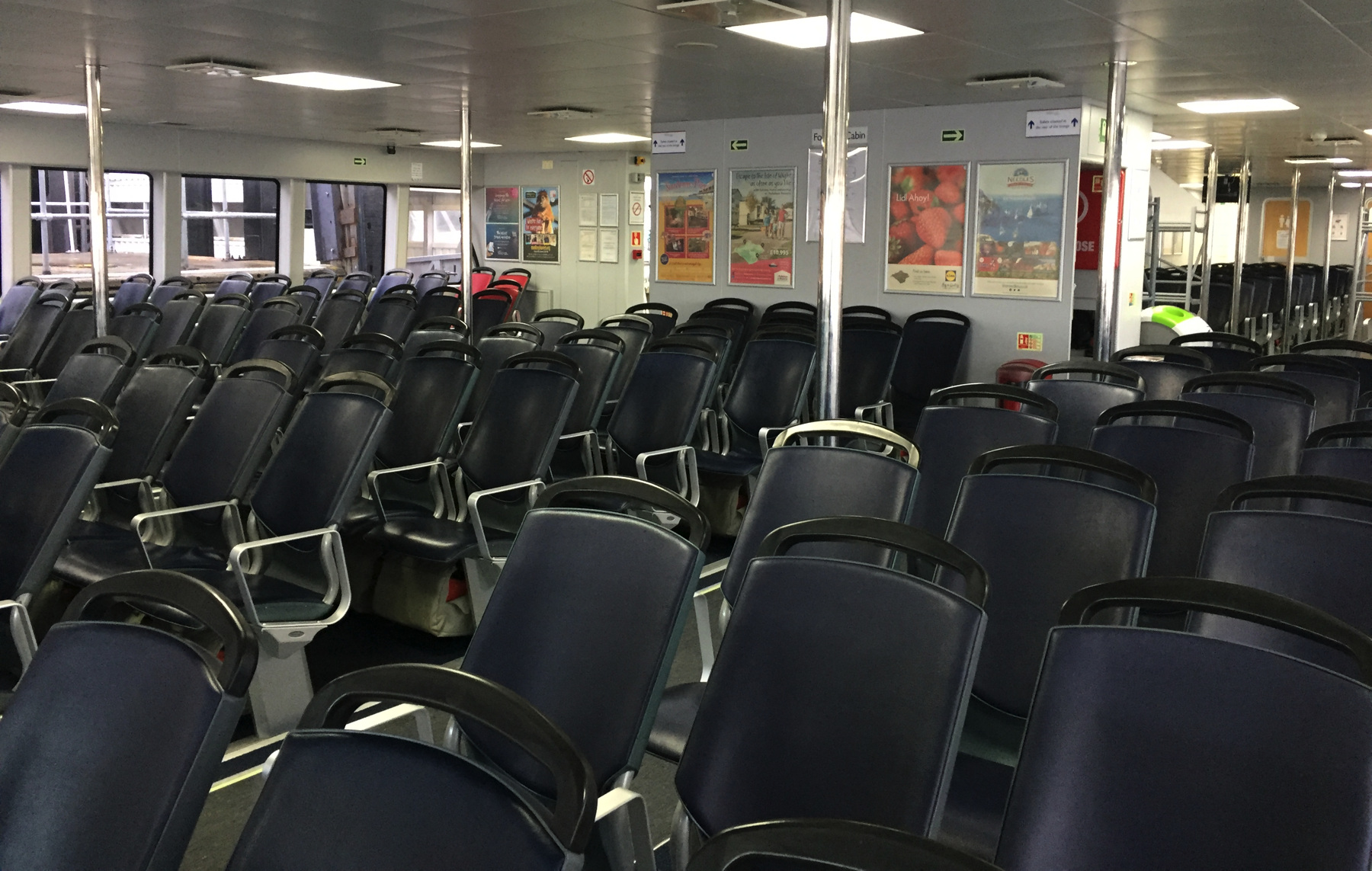
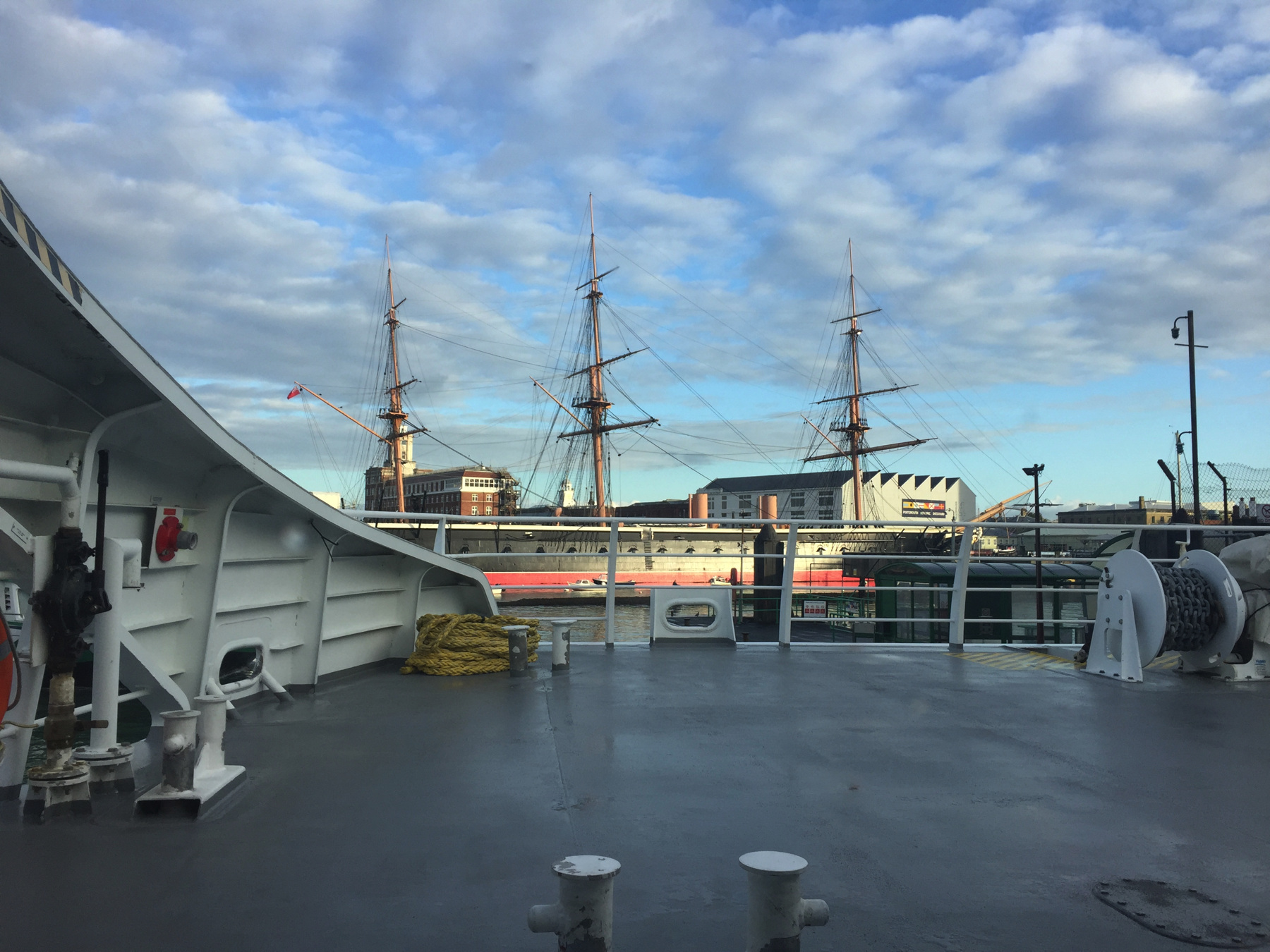
That's HMS Warrior there, seen from the ferry. A beautiful day, right? Just wait.
It was raining when we reached Ryde Pier Head. It's almost half a mile to town, but the Island Line railway can take you there. Did I know, a sign poses the question, that it's really three piers side by side? No I did not know. From south to north, they are the railway pier, the derelict tram pier, and the pier for pedestrians and very lightweight vehicles. If you walk way out to the end of the railway station platform, you can see clearly that there are three piers. The tram service, which went only the length of the pier, ended in 1969.
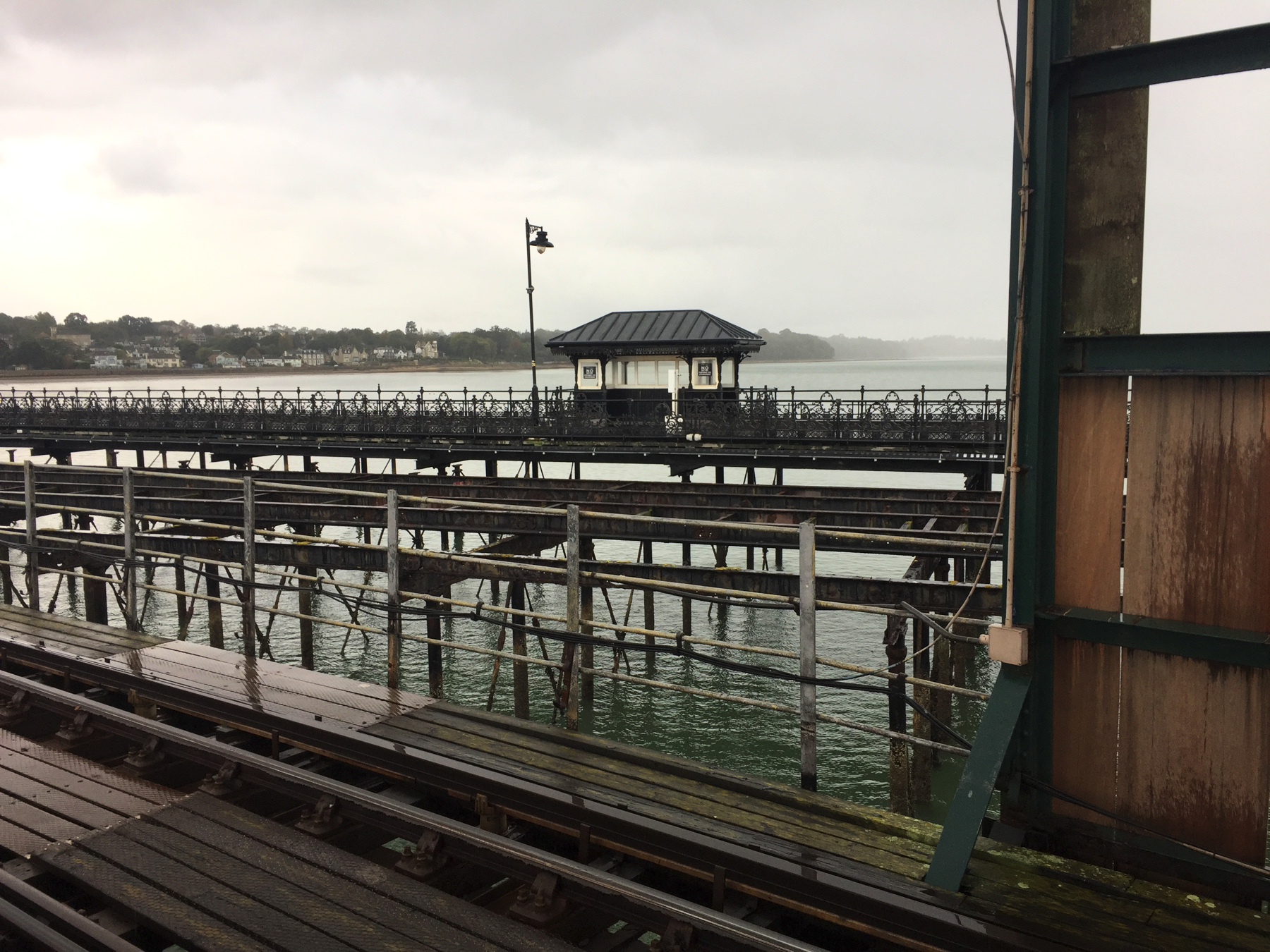
I had plenty of time to walk out there and back because only one of Island Line's two operable trains was actually operable on this date, and so it could offer a service only once an hour instead of twice. For the most part South Western Railway, Wightlink, and South Western's Island Line form a neatly coordinated hourly service between London and Shanklin. As I mentioned the train I used was off the hourly pattern, which was to my advantage at Portsmouth Harbour, and normally it would have connected with the "in between" train service on the island. Because of the outage railway tickets were to be accepted on bus services, but I could not get to a bus without walking the length of the pier. I wanted the train anyway, so I waited.
Pier Head station opened in 1880. It was mostly rebuilt between 1967 and 2009 into the form we see today, leaving little trace of its one-time Victorian style. Not surprisingly every suggestion on the Onward Travel Information sign begins with getting yourself off the pier.
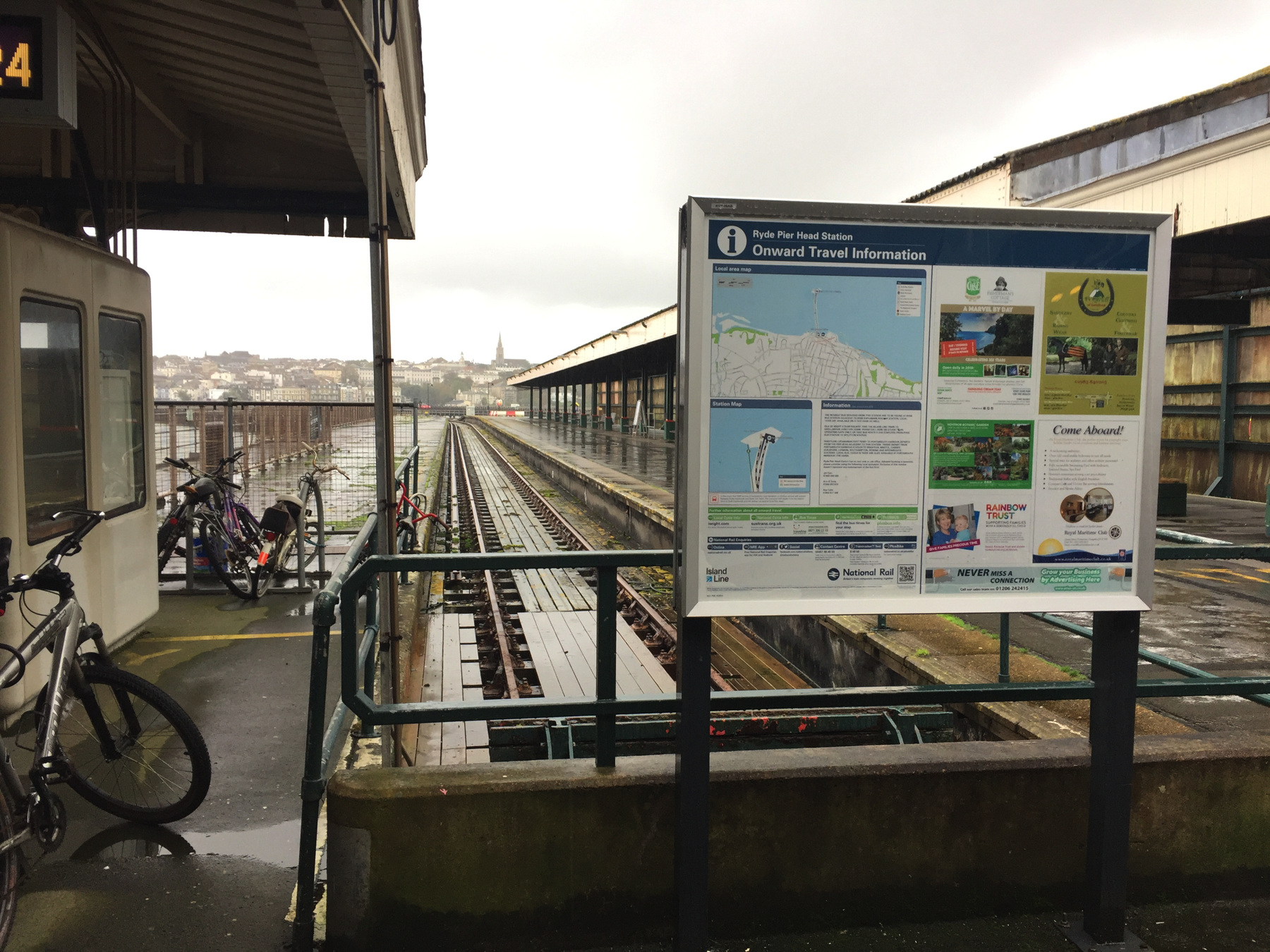
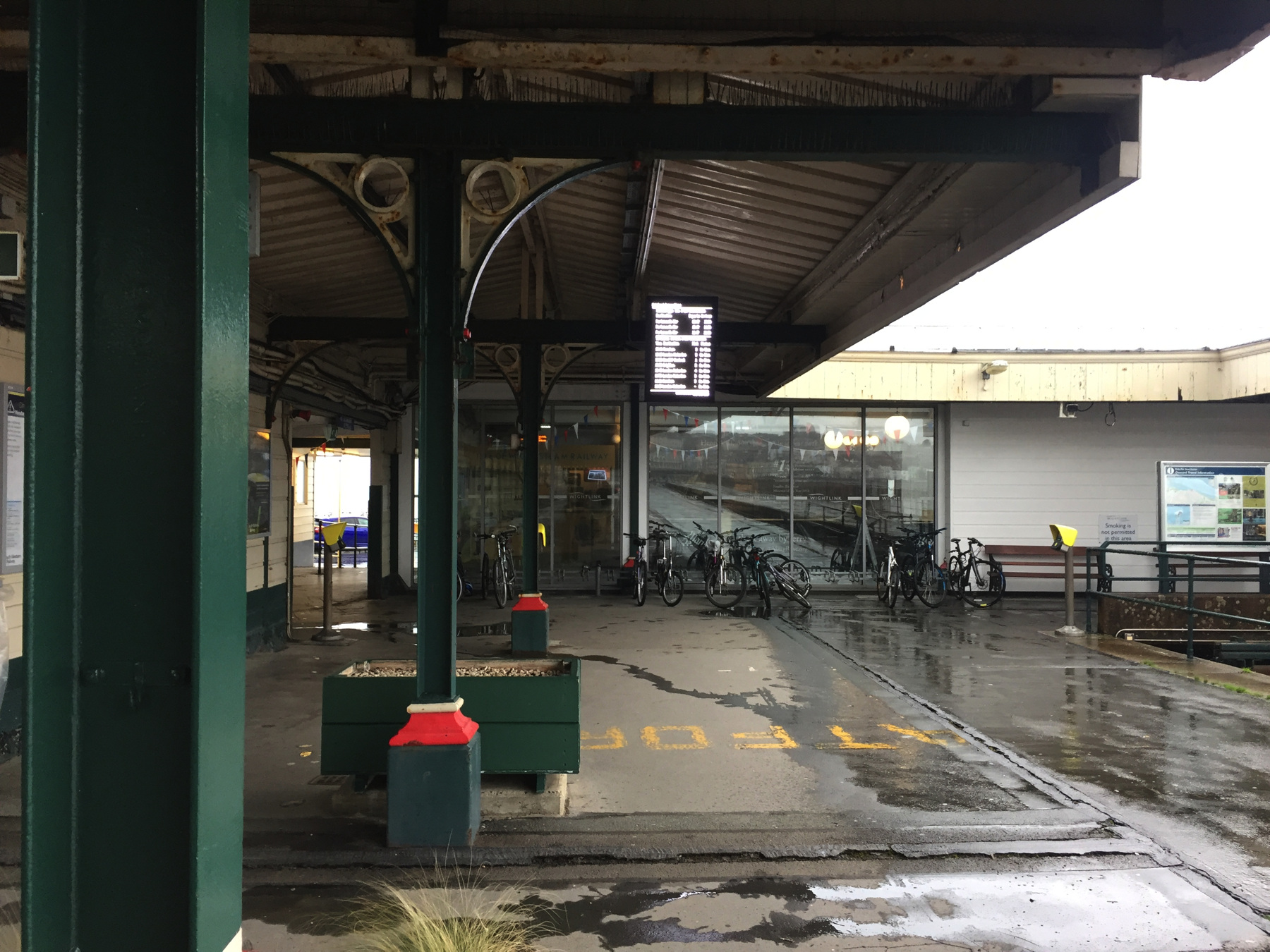
You might notice in the itinerary that the scheduled time from one end of the Island Line to the other is 24 minutes, which leaves about six minutes at each terminal to discharge passengers, change ends, and go out again, in order to maintain an hourly schedule, but that is the way the railway is run every day. Normally the other train runs in between, but not halfway between, because the passing siding of the mainly single track railway is not at the halfway point.
Below— Here comes the train. Yes, Island Line is the farthest place from central London with regular service by the Underground— so to speak.
This was of course the first of the two things I wanted to see.
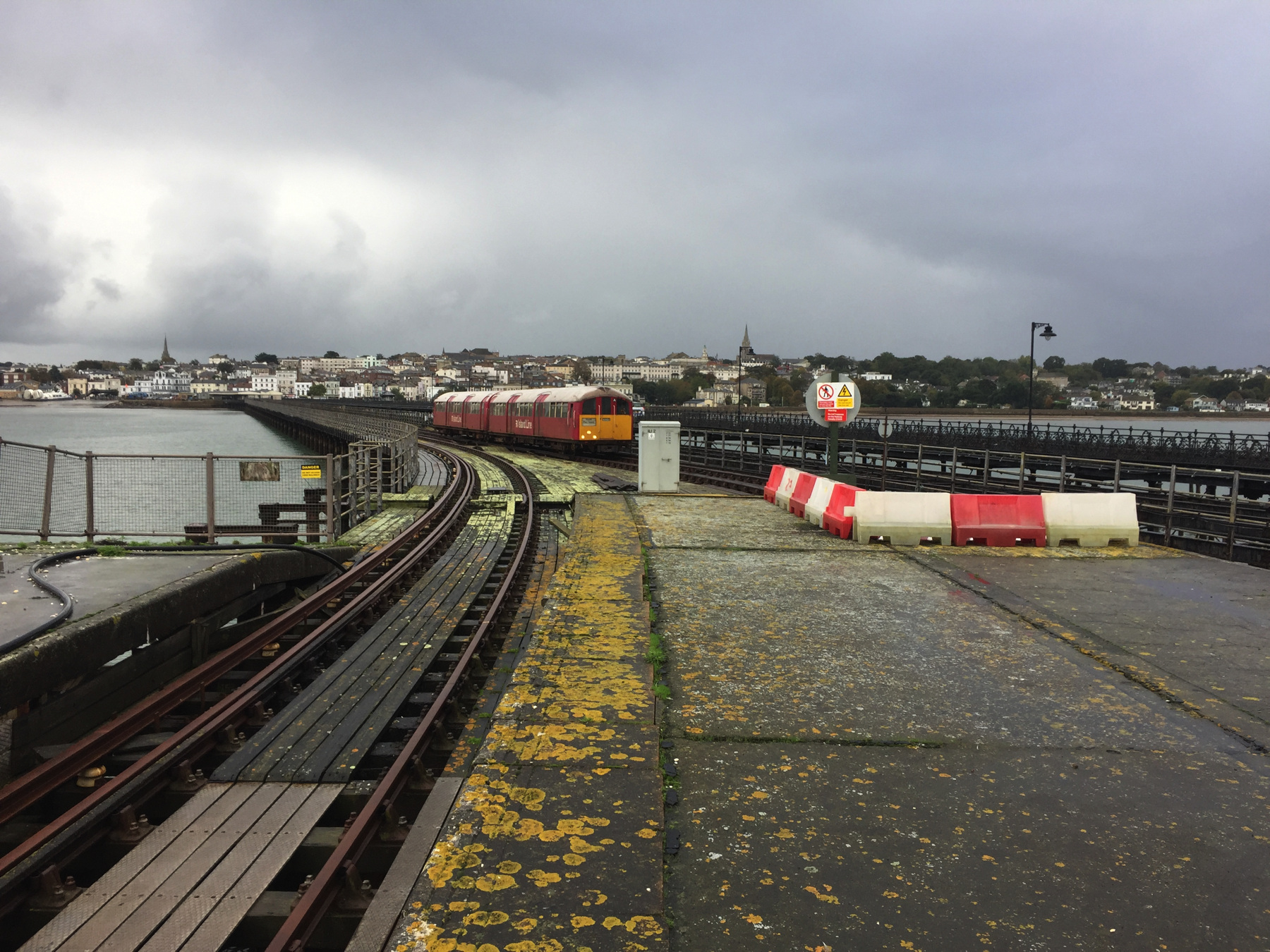
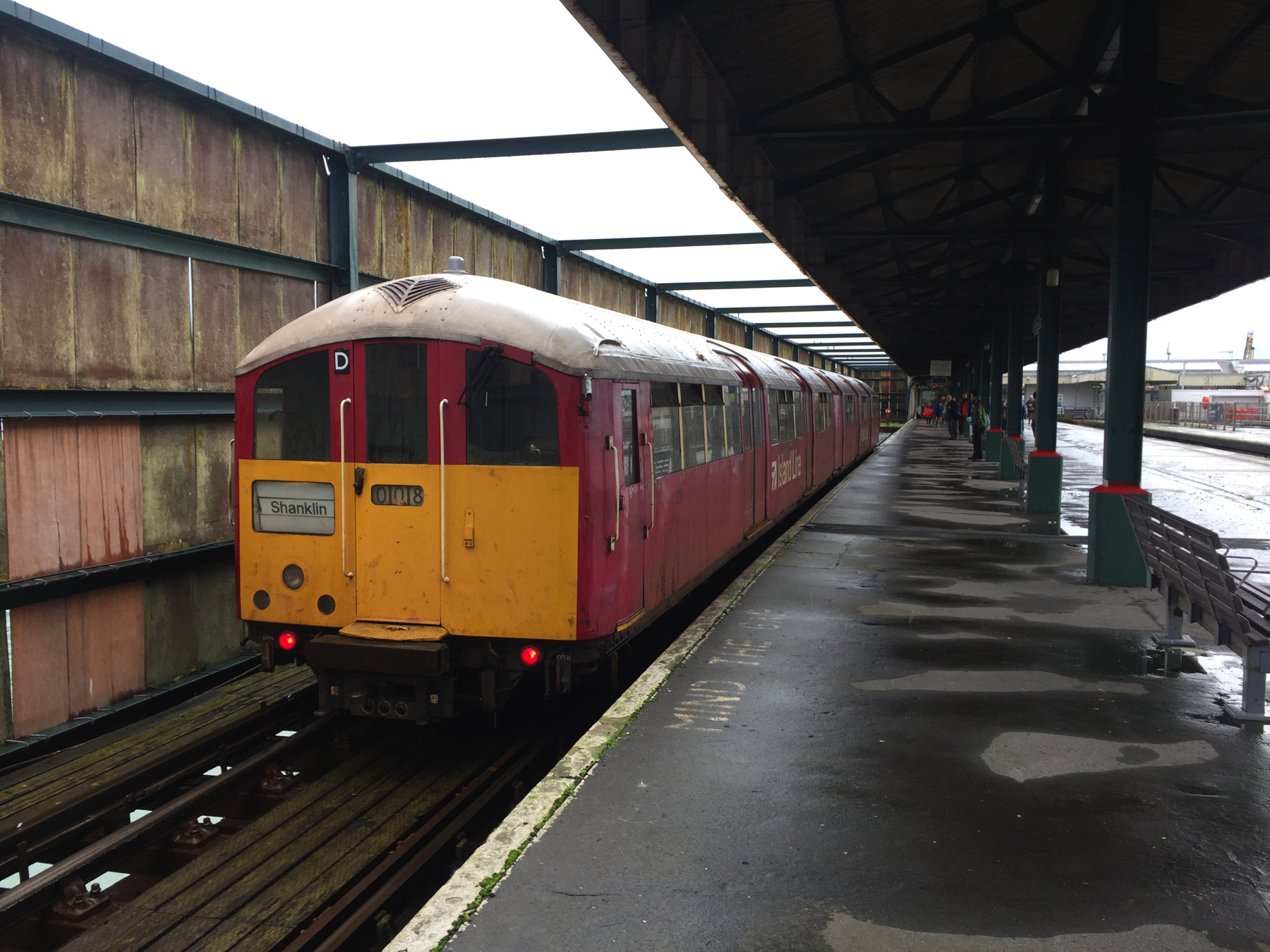
The Underground trains need a little explanation. In the early months of 1967 the railway was converted from steam locomotive to third rail electric operation, and renovation of Pier Head station began, and the tunnel under Ryde town was altered to reduce flooding. In most places flooding in a tunnel might be reduced by installing drains, but in this case the brilliant solution was to raise the floor. As a result standard railway equipment would be too tall to fit, so to deal with that, trains of surplus London Underground "standard stock" roughly forty years old were acquired and put into service.
In 1992 those relics of the past were replaced by surplus "1938 stock" which were obviously more than fifty years old, and at the time of my visit they were more than eighty years old. It's little wonder that only one pair of cars was still available, and more of a tribute to the maintenance staff of Island Line that any of them are still running. May I offer my respect for work well done for so many years. The fleet is scheduled for replacement in 2020 by... rebuilt Underground "Class D stock" from the early 1980s. The tradition of running cast-off equipment must be upheld. The Ryde tunnel does not require trains as small as "tube" stock. The larger size used on the Metropolitan or District lines also meets the height limitation.
Below, two interior views of the 1938 stock. The first, at Ryde Esplanade station, where heavy rain had started again, shows the wooden window sash, and the second shows more wood panels across the front end of the car where the "private" driver's cab is located. The moquette on the seats is of course not original but in keeping with the seat covering on any Underground train.
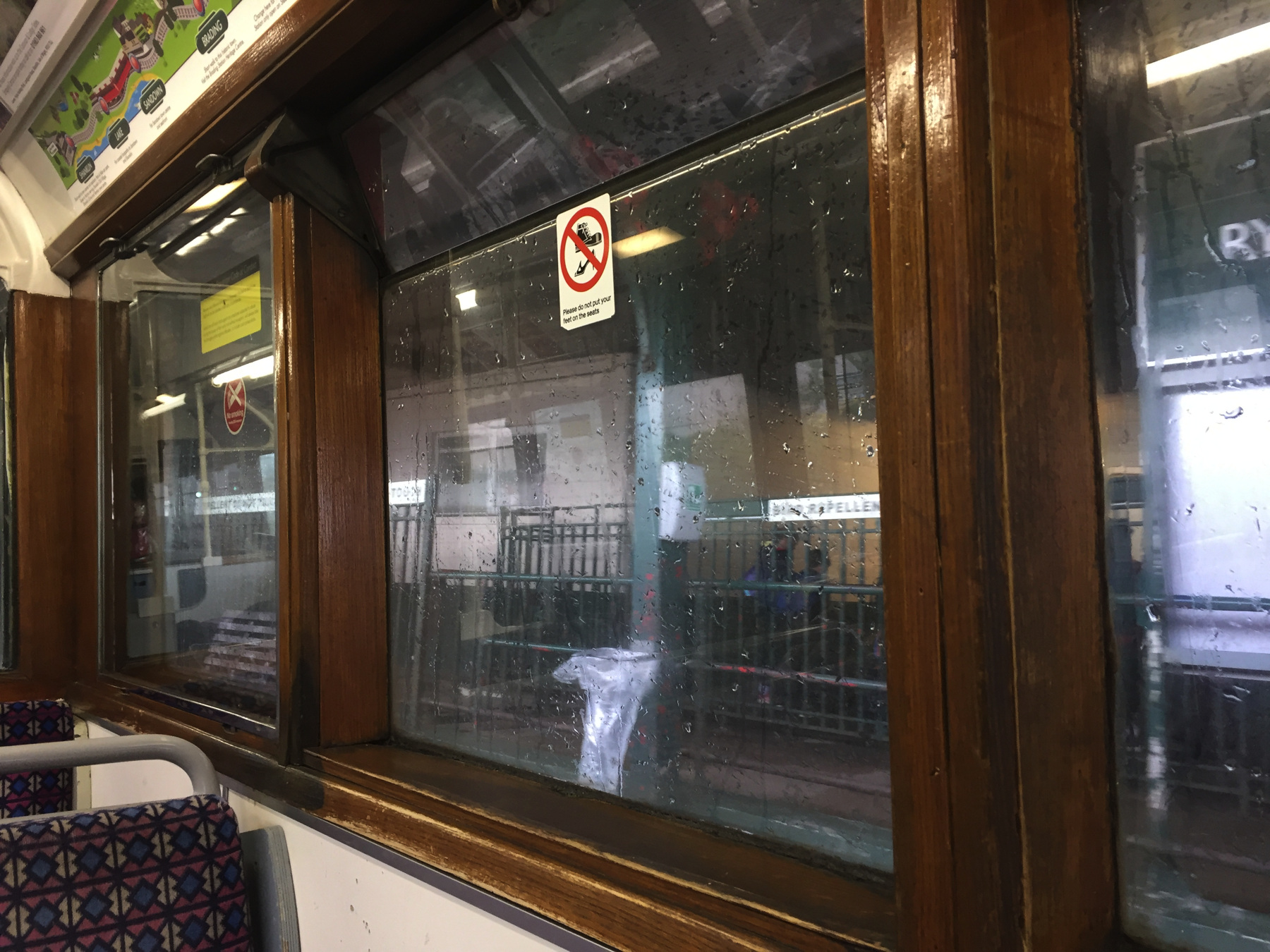
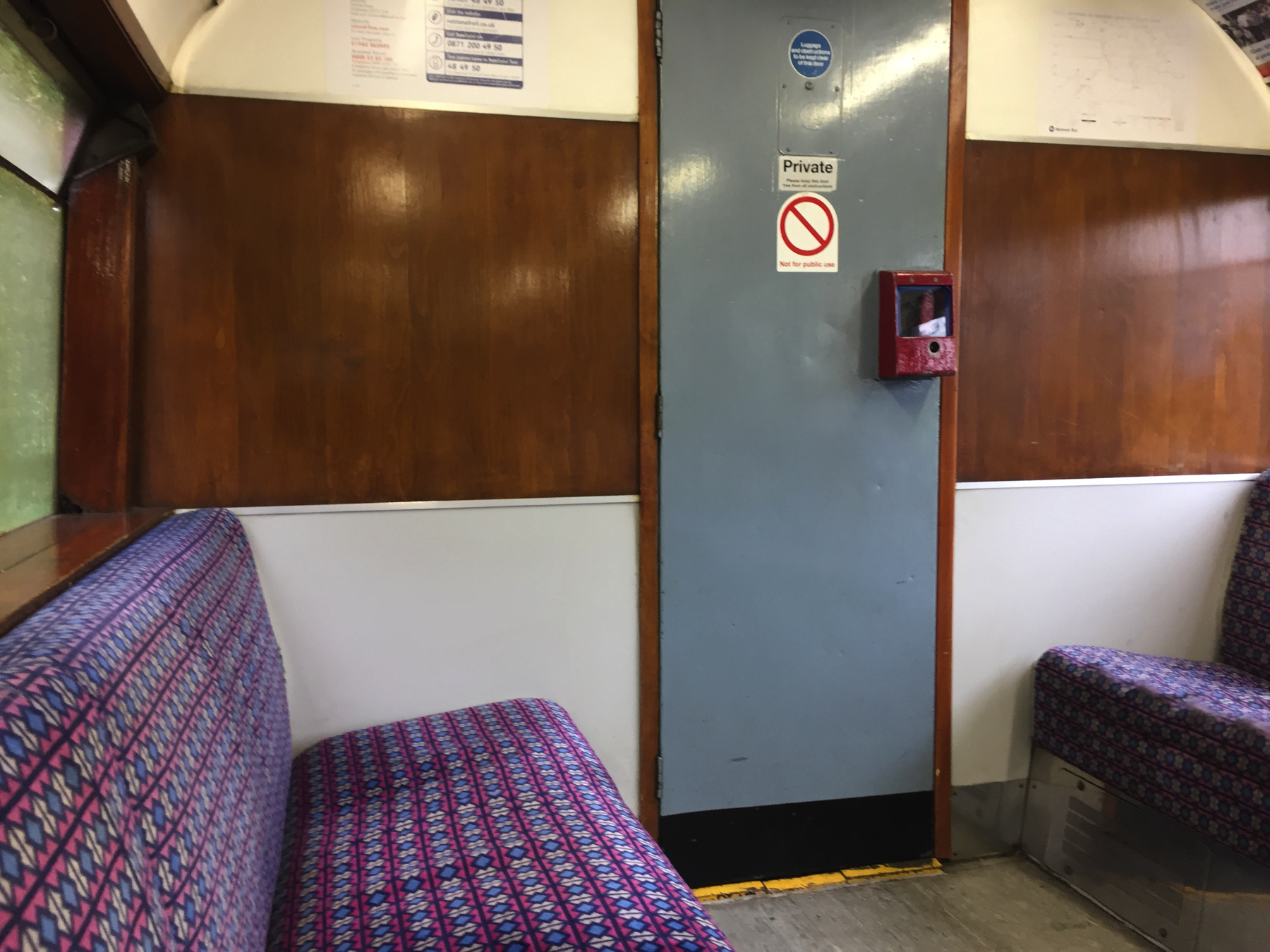
I was able to stand at the door and grab shots of Ryde St John's Road, the original terminal in 1864, and the intermediate station at Brading of the same date. The difficult monogram in the ironwork in both places is IWR for the Isle of Wight Railway. The property near St John's Road is the home base where the wonders of maintenance take place. The equipment on the side track is a bit worse for wear than what I was riding in.
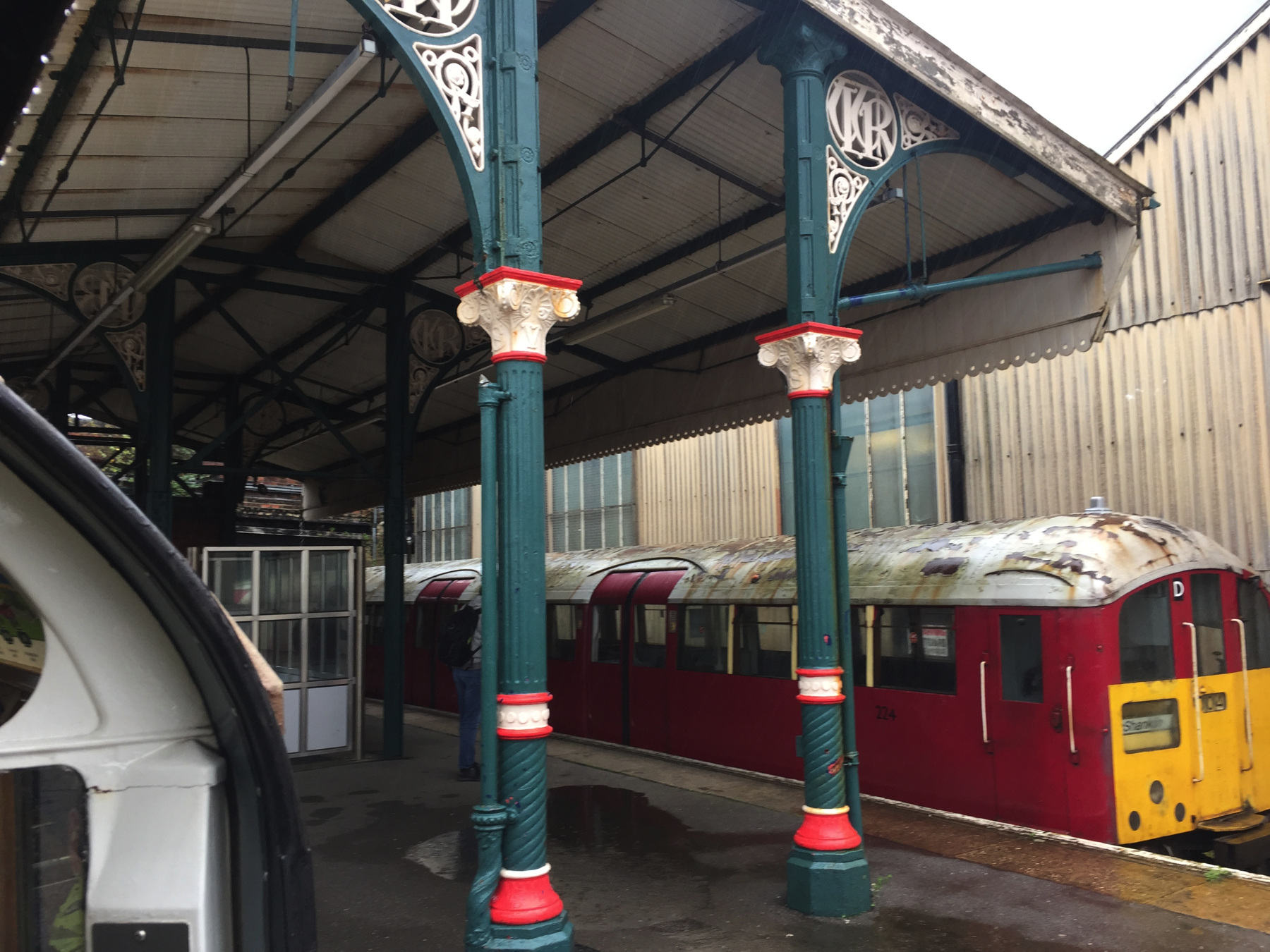
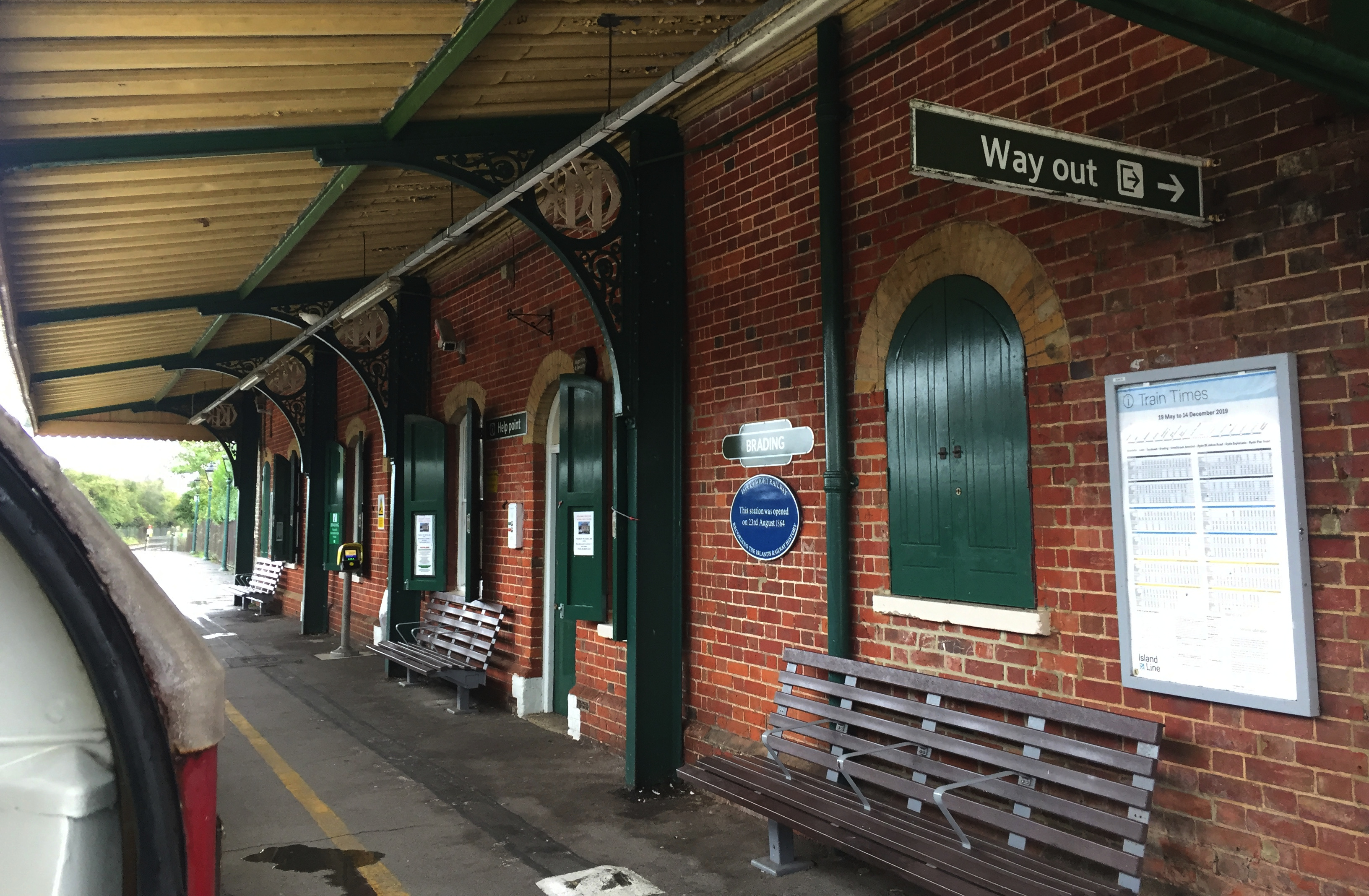
Shanklin is the other end of the line. I brightened the exposure so that you can see the details in the station. In reality the rain was still coming down pretty bad as we arrived.
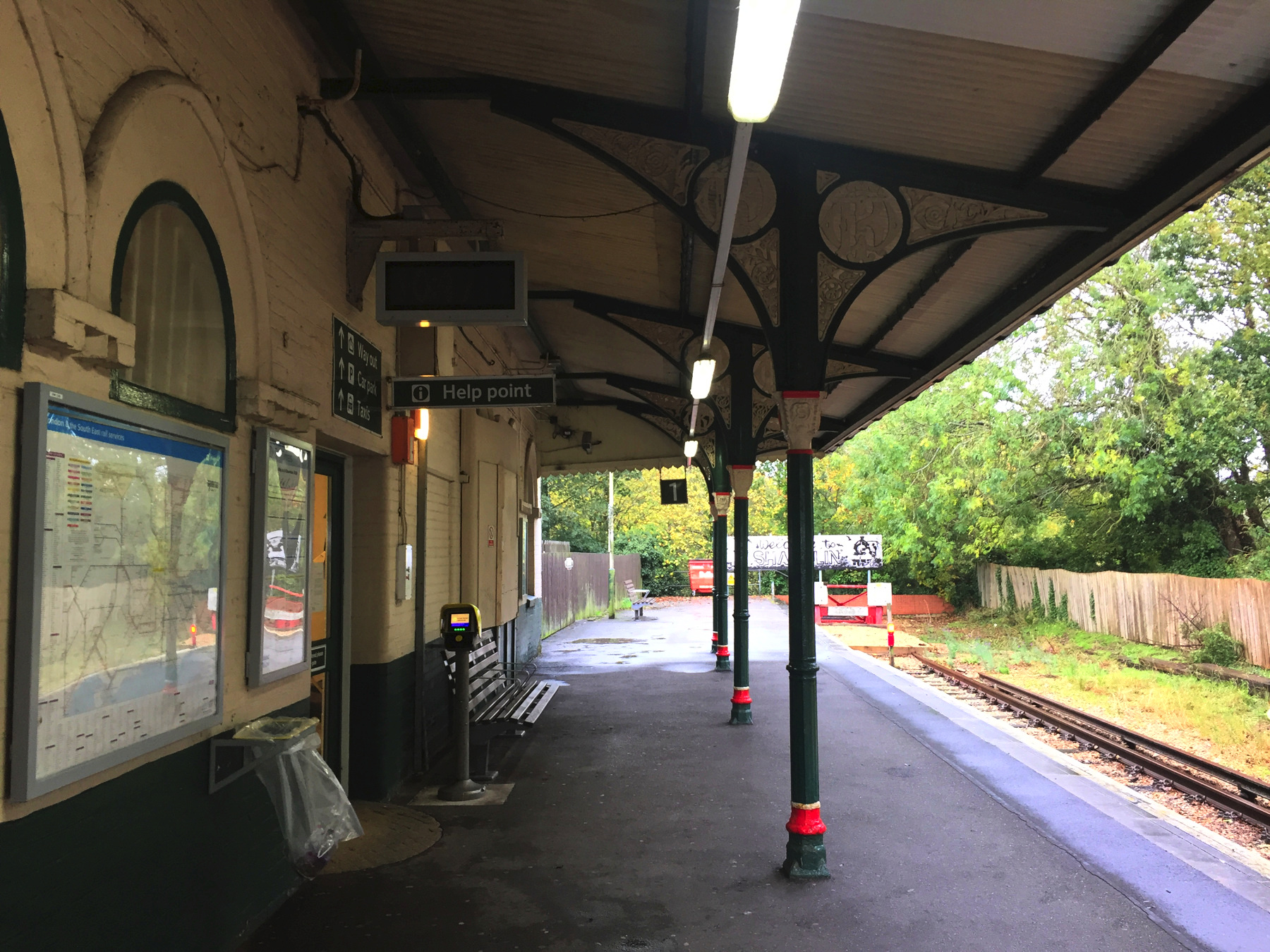
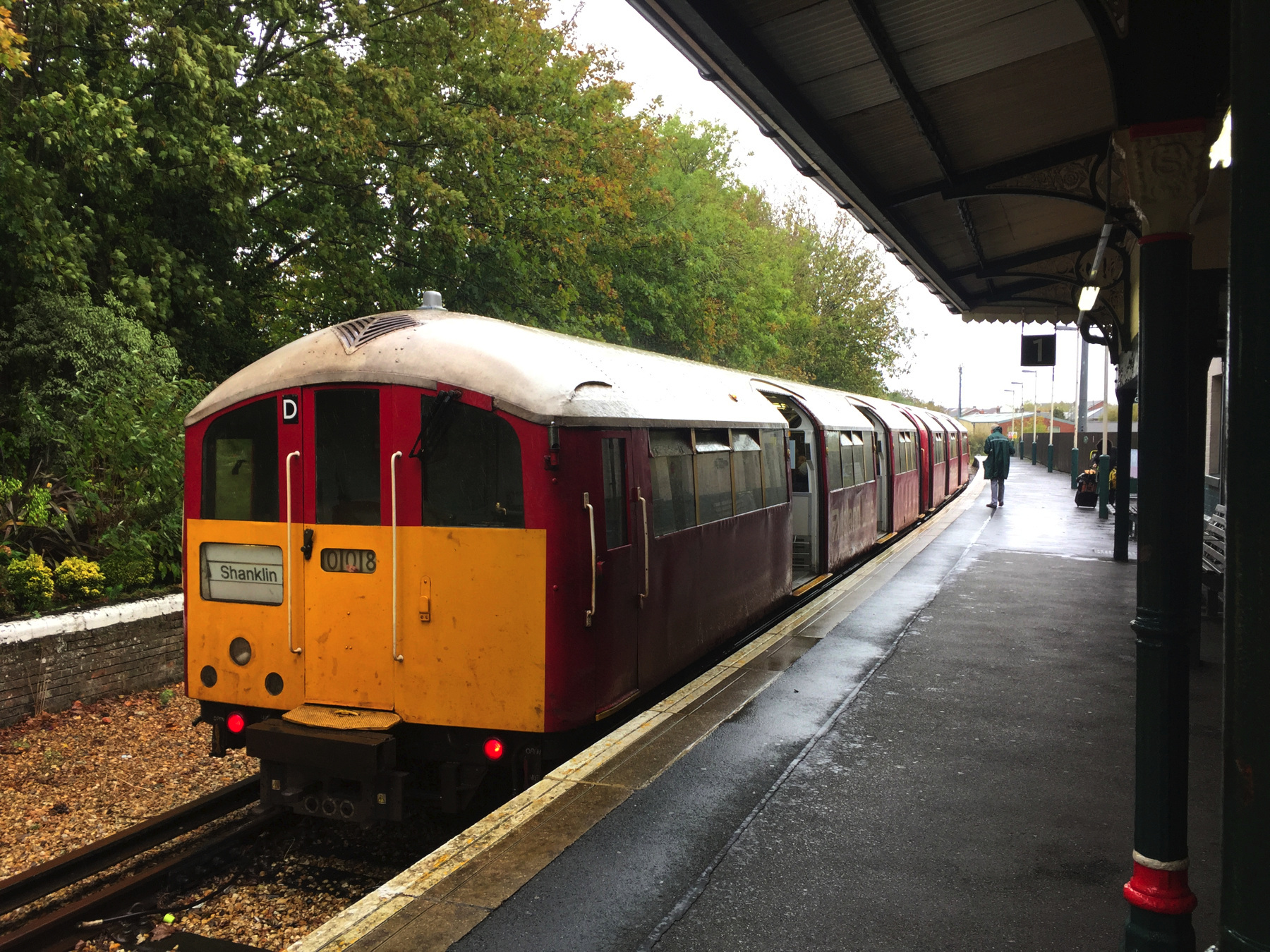
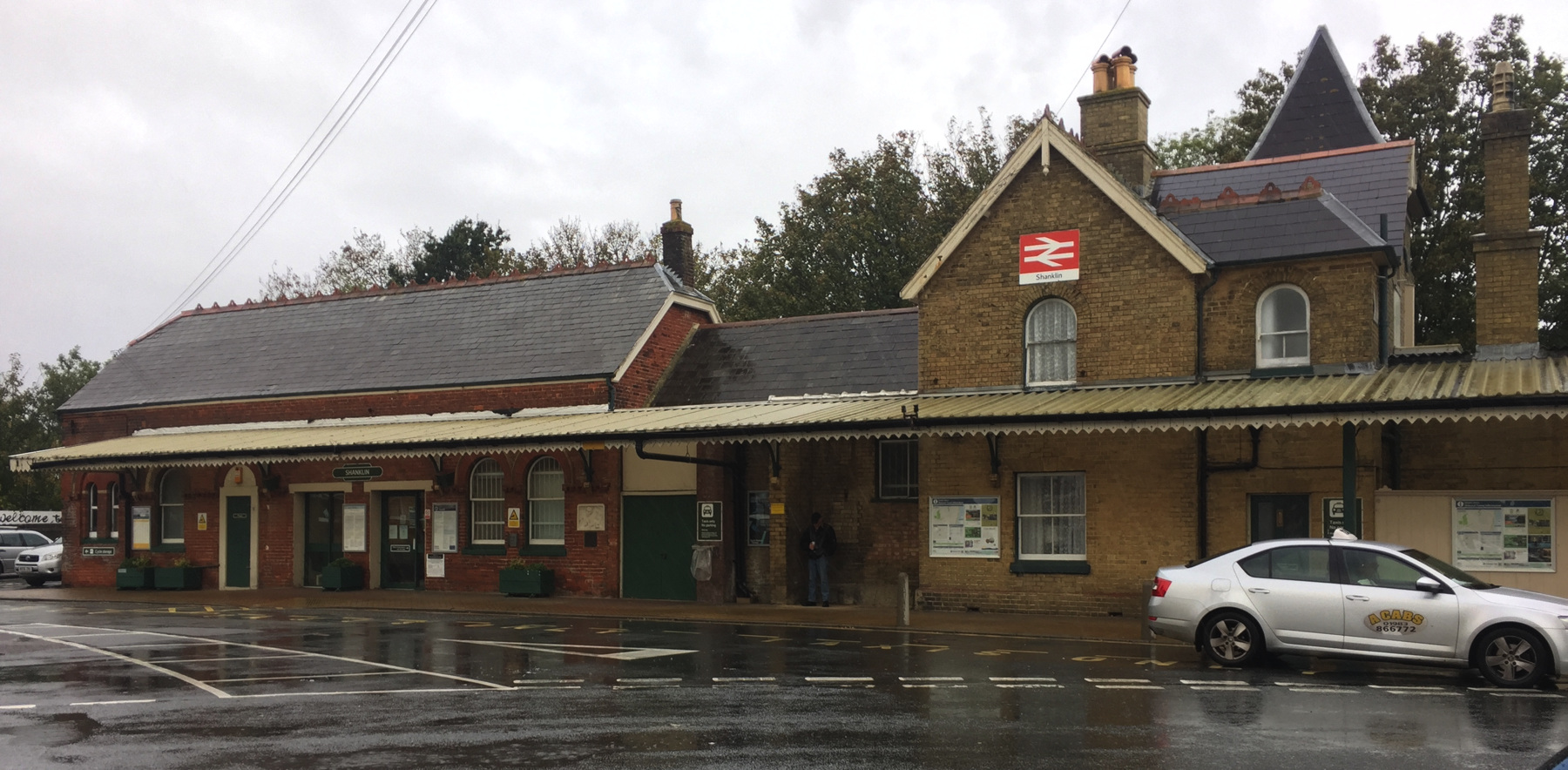
I figured it could not rain any harder than it was already, and besides it's only water. I was eager to see the cliff lift, so rather than loiter at the station I set off down the streets of Shanklin. I was wrong about the rain.
When I got to the Eastcliff Promenade and looked down, I thought, that's a long way down. This would be a good place to have a cliff lift.
The alien life forms in the foreground are ivy flowers. Only very old ivy plants set flowers, and I am not used to seeing them. I have ivy around my house that's been there for at least a quarter century and it hasn't flowered yet.
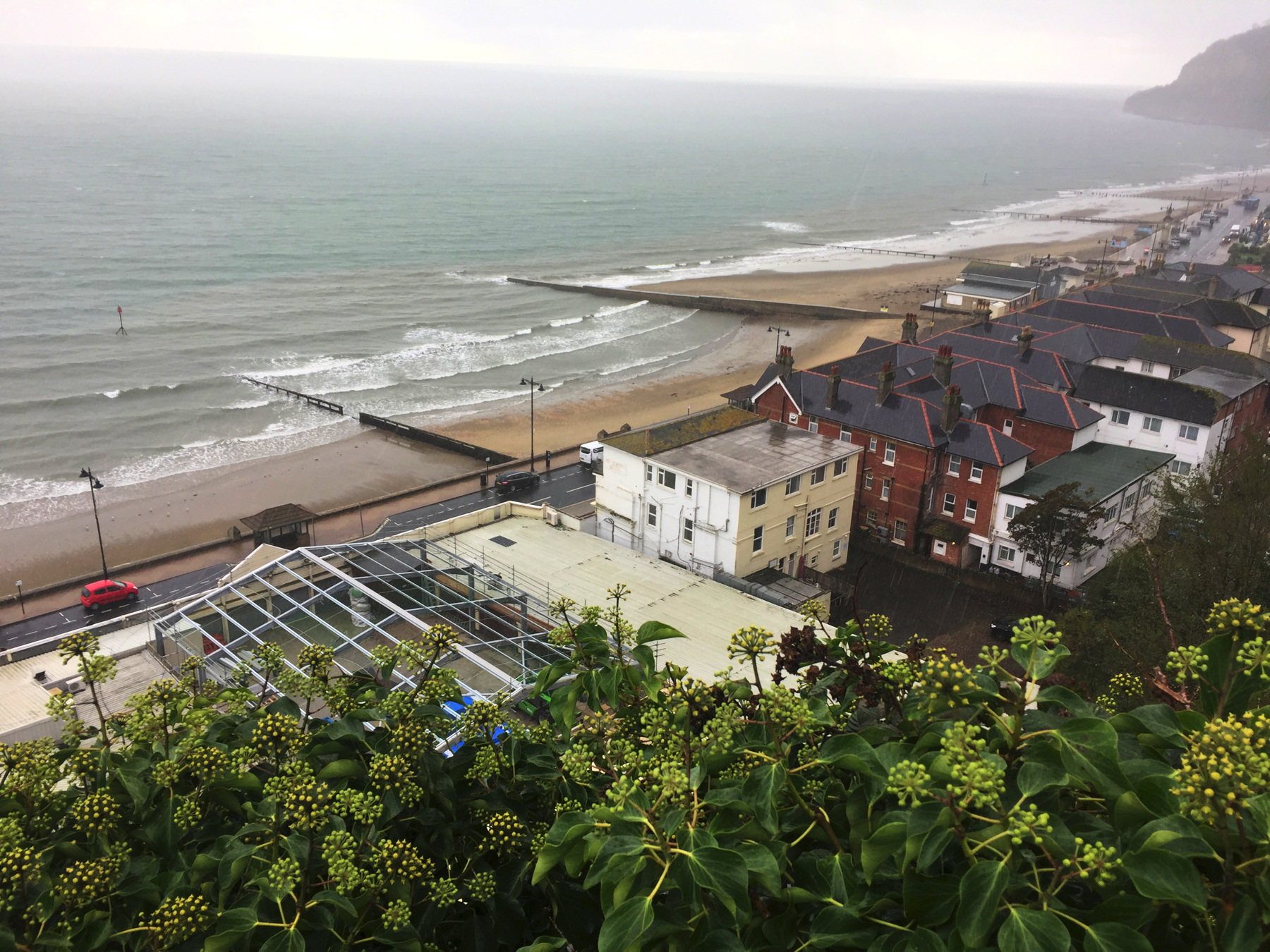
There was a LIFT, in huge letters, and that is what it was, what they call a lift in Britain, what I would call an elevator. By the time I got there it was absolutely raining buckets. It was cats and dogs. It was drenching. You wouldn't put a dog out in it— no matter how feel about dogs. Even from my short walk I was soaked to the skin. I joined a few other people waiting in the covered footbridge that led to the disappointing LIFT. The man sitting in a chair in the lift car, who collected fares, was not concerned about people taking shelter. We weren't in the way of anyone who wanted to ride. I was the only one of us who decided eventually to go down.
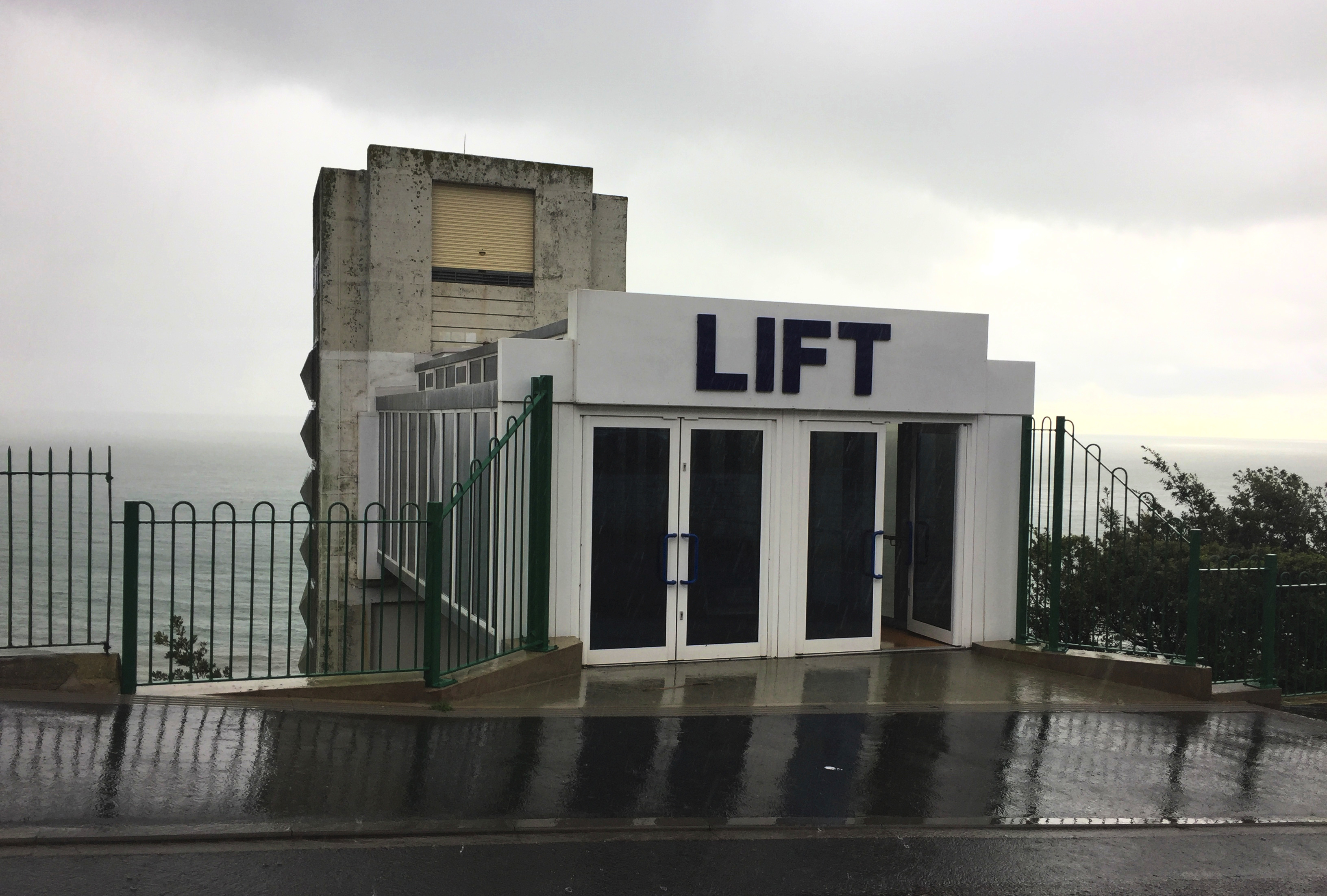
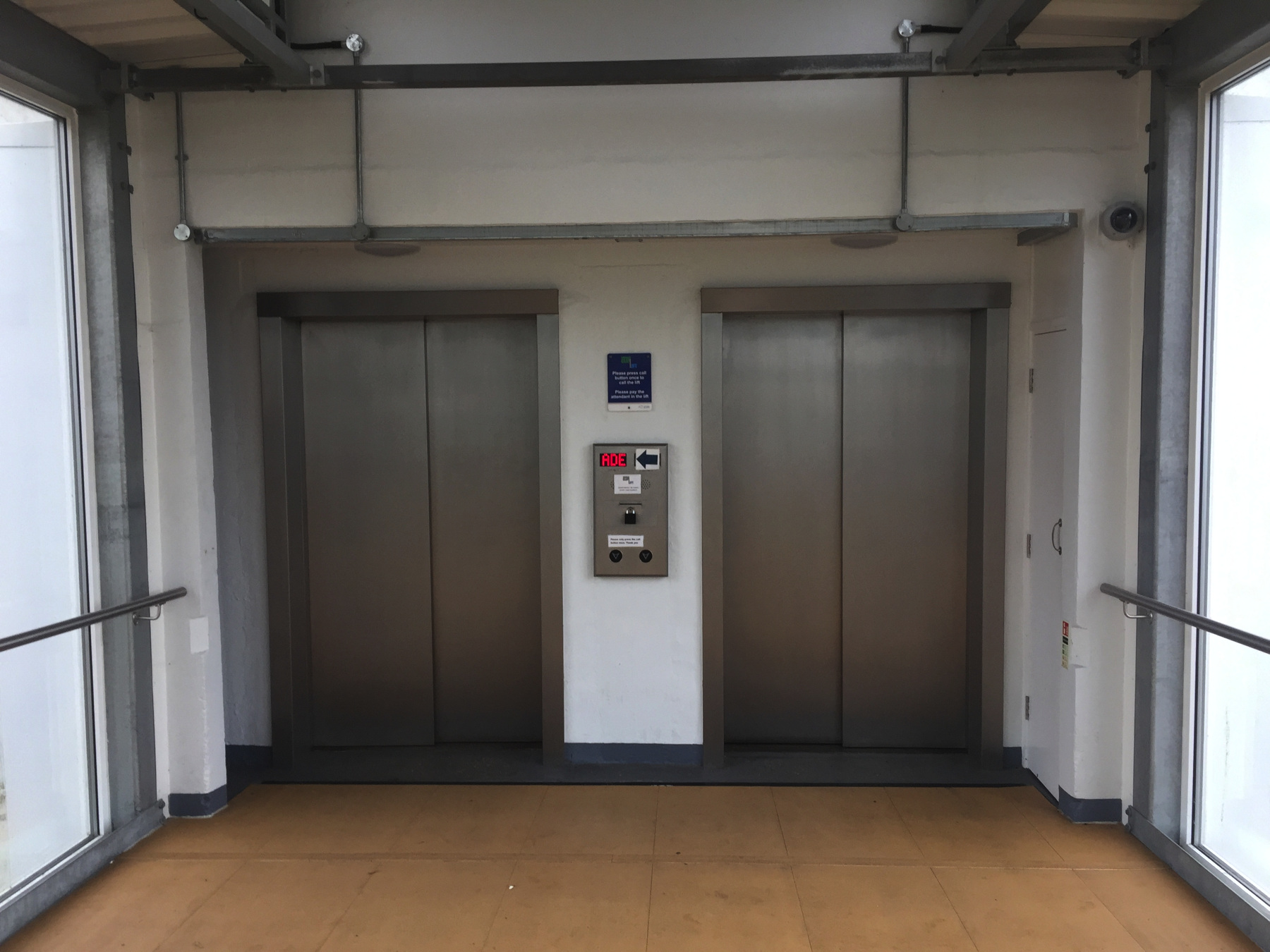
It was raining only lightly when we reached the bottom of the facility that must be in a tie for the steepest cliff lift in Britain. I walked out to see the sea.
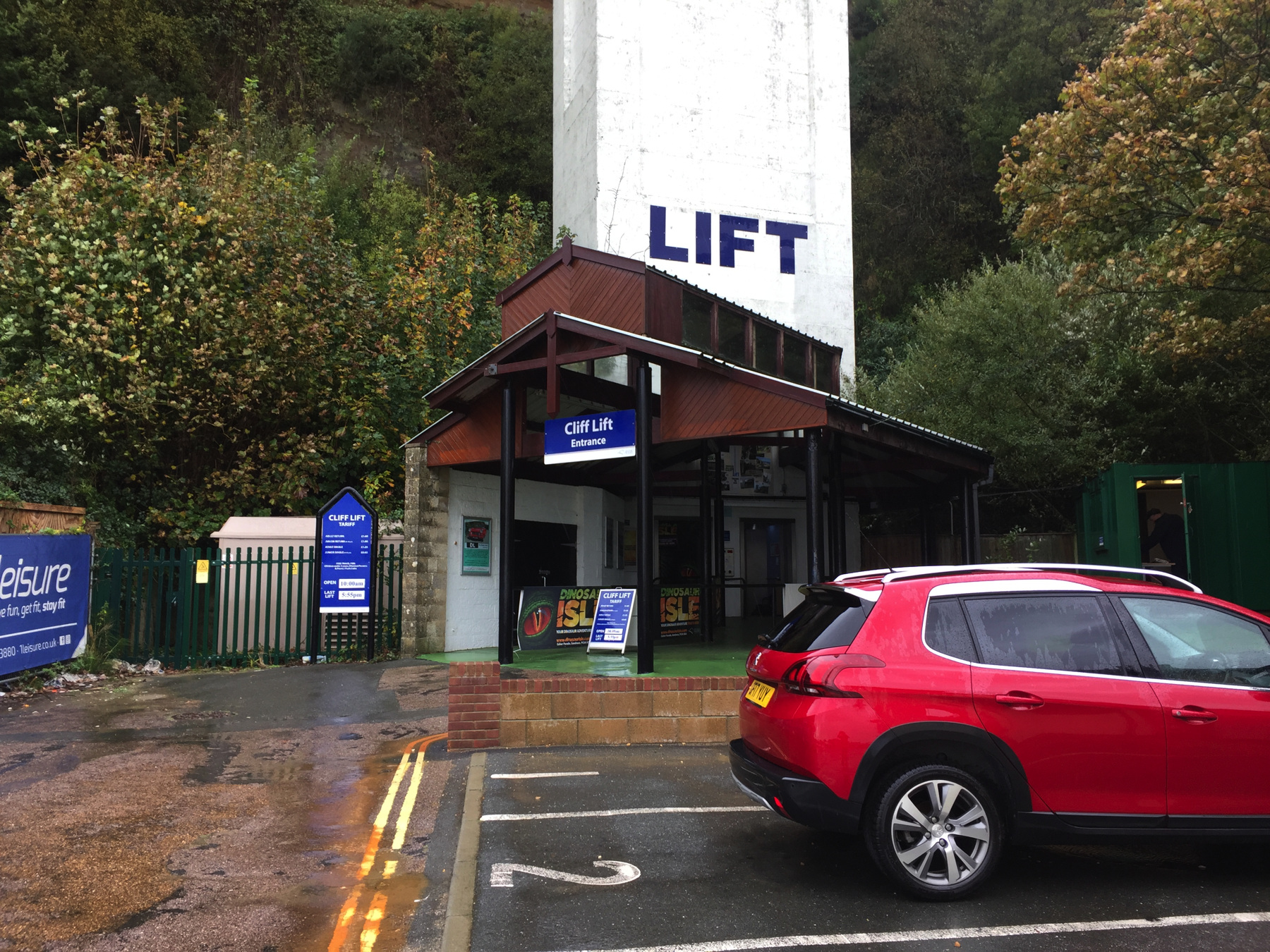
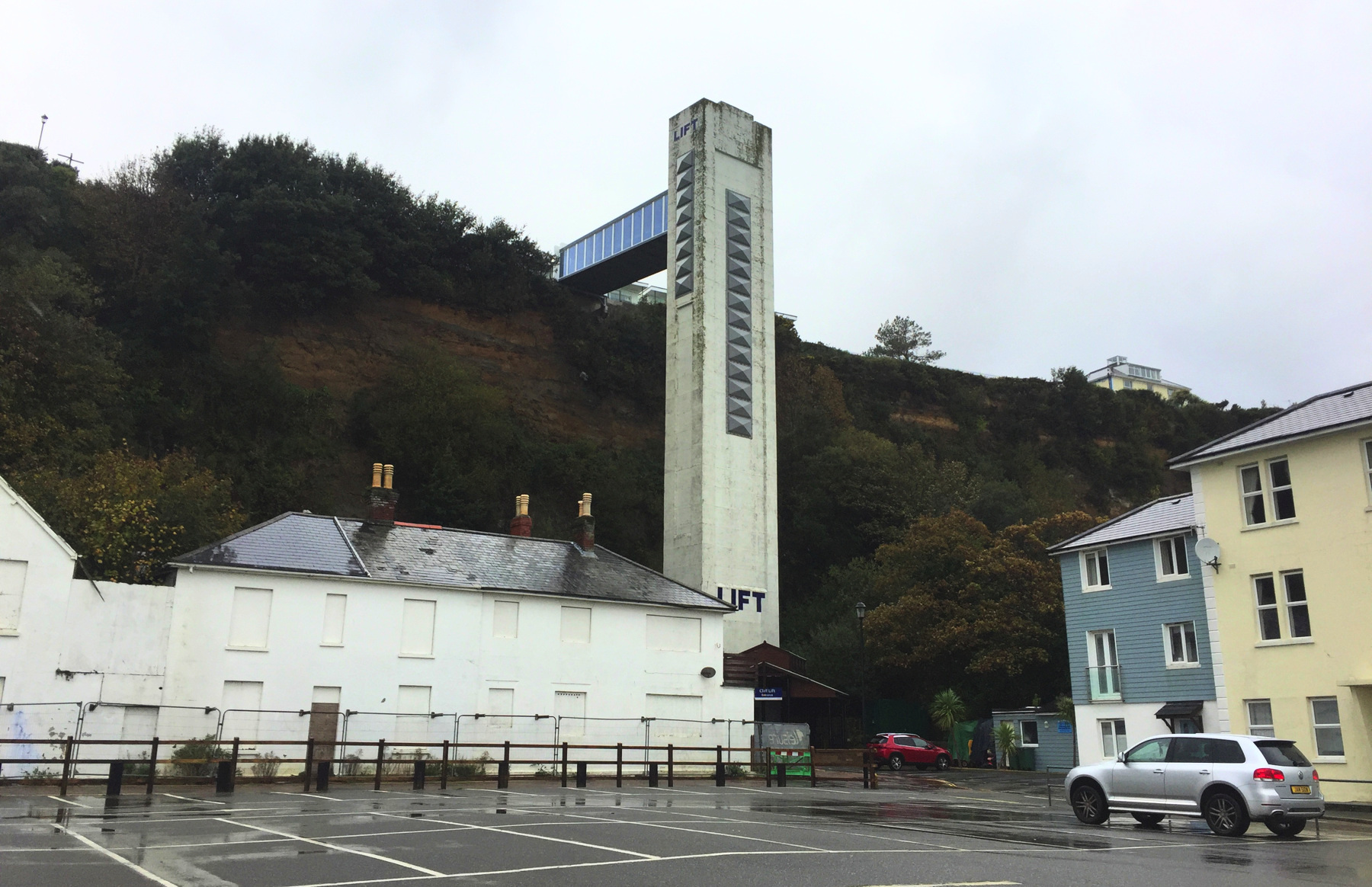
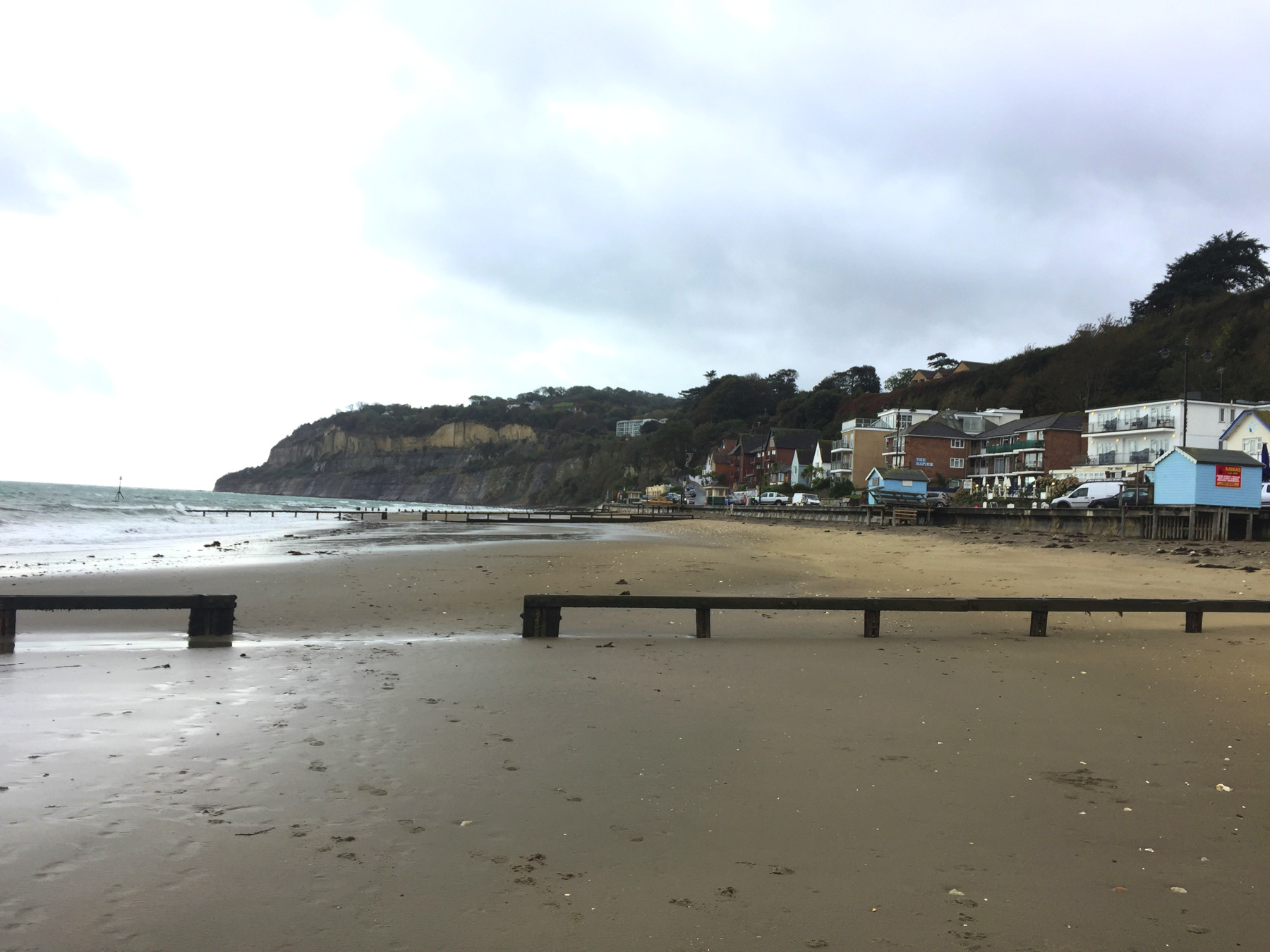
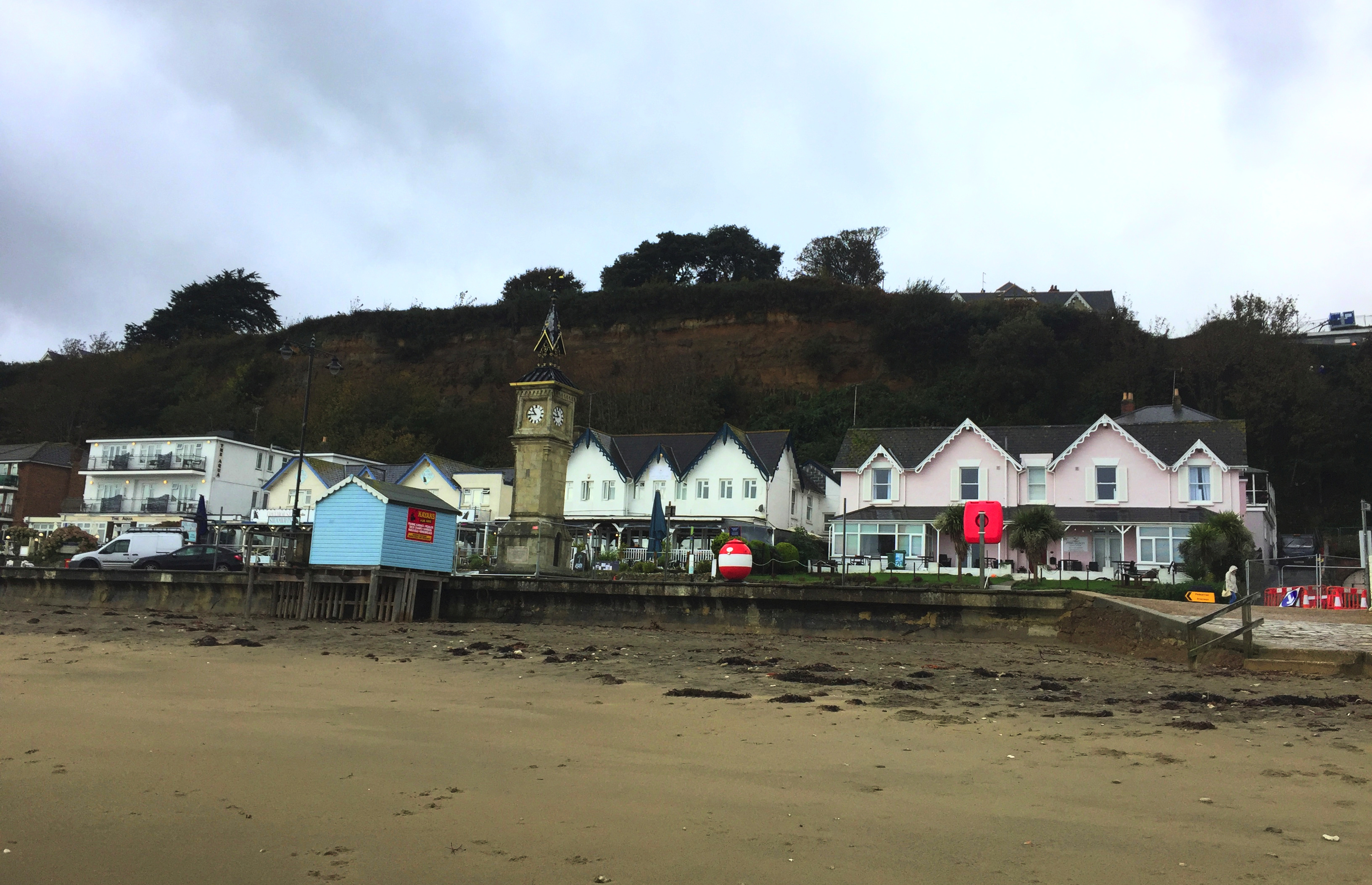
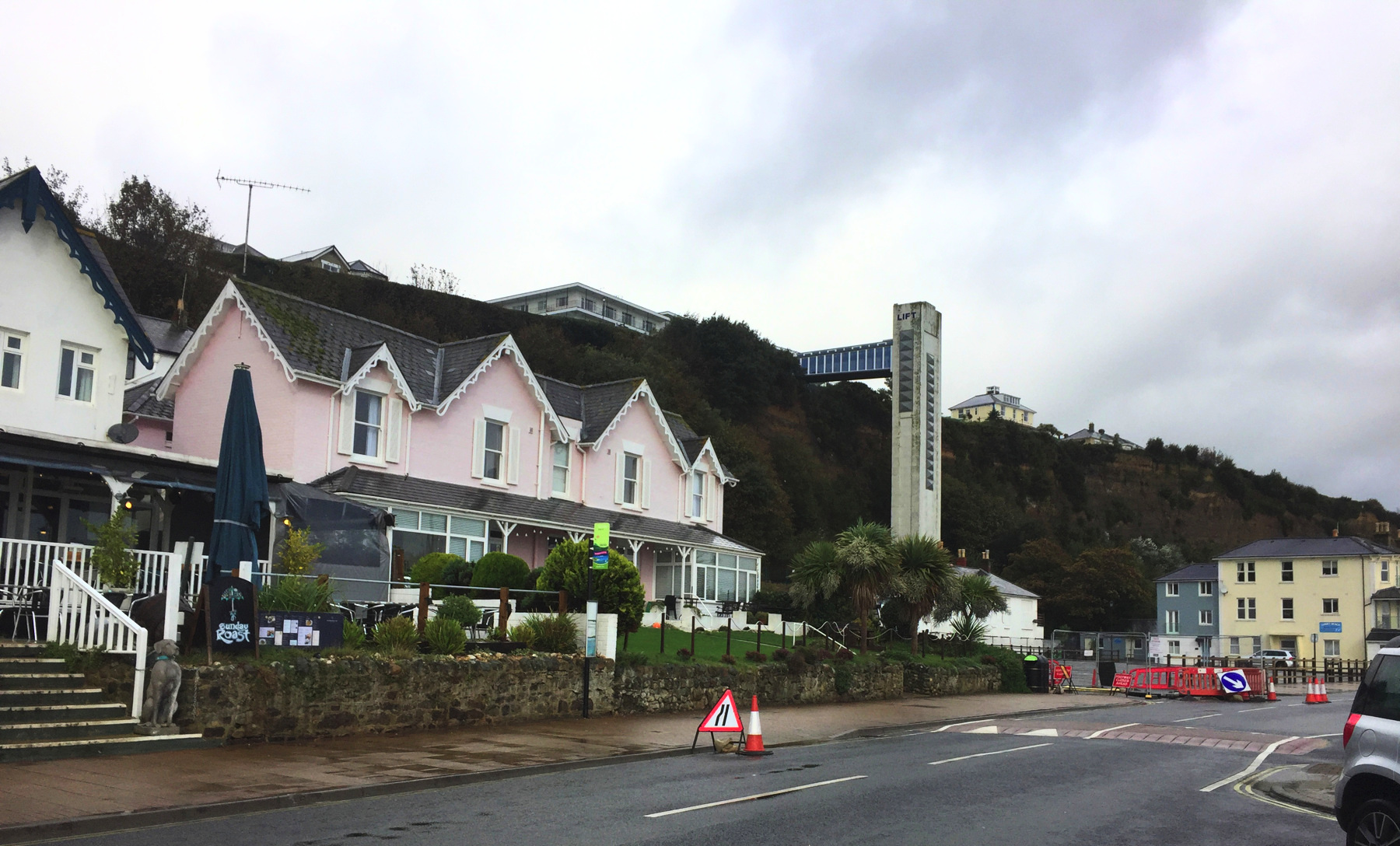
There was another dark cloud approaching, so I walked back to the LIFT.
The man was once again sitting in the chair in the lift car. Maybe he had not gone up and back the whole time I was on the beach. I pulled the flimsy paper return ticket from my wet pocket and offered it, apologizing for its condition, and I think he understood. He probably remembered me. Because there are two elevator cars, I had to ask. When this one goes up, does the other one go down at the same time? Of course, he said. At that moment we reached the top, and the door opened, and lo and behold two women were waiting to ride down. Rather than delay other passengers with my idle conversation I went out. I wonder what he meant.
My next goal was to go a few blocks to the bus station in the middle of town. Naturally the light rain became a torrent exactly when I was midway between shelters. I stood for a few minutes under the awning of a shop. I mentioned to another man there that I had not asked for this rain, and he told me he had not done so either. It occurred to me that I could hardly get more wet than I was, so there was no reason to wait. When I got to the bus station, which turned out to be a couple of bus stop signs, I found the bus I wanted ready to go. Single ticket. We don't do return fares on the island, the driver said amiably.
My destination? Godshill, the home of Godshill Model Village, the model village that is a model of the village it is in. That was the second thing I wanted to see (that is, besides the LIFT.
Here is a model of the entrance to the model village. You go through the arch and pay your admission at the octagonal booth, and then keep to the left. On the way out you pass through the white building to see the souvenir shop.
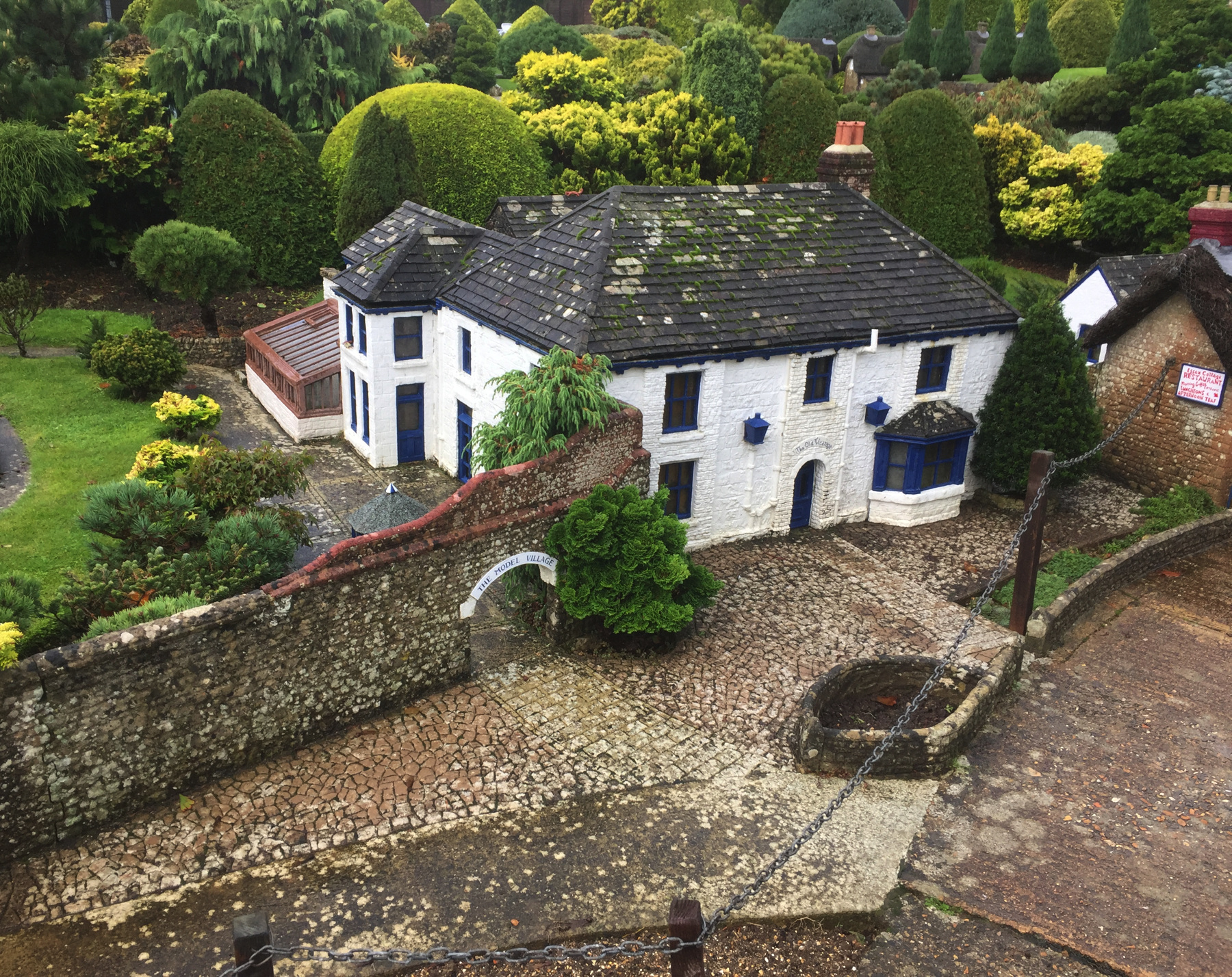
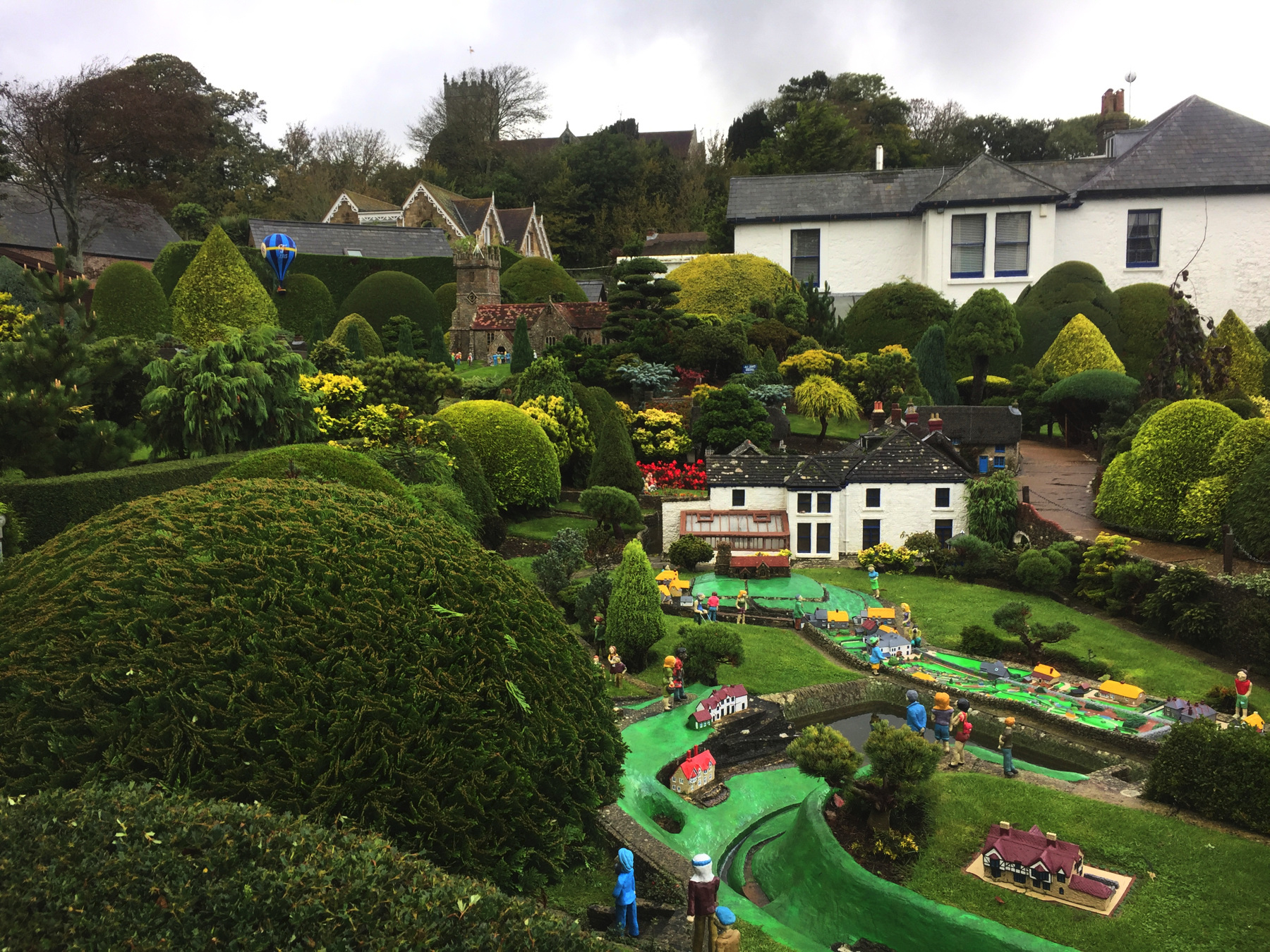
Above, behind the tree, top left center, is the church on God's Hill, and below is the model of the church, and below that and to the right is the model of the model. Just above the model of the model is the model of the white house, with its full-size exemplar above, and the model of the model below. The bright green area this side of it includes the the model of the model of the model at 1:1000 scale. Please pardon the intrusion of two giant houses between the church and the model of the church.
Godshill Model Village has won awards for horticulture. The scene below has living miniature trees and shrubs, and even miniature grass.
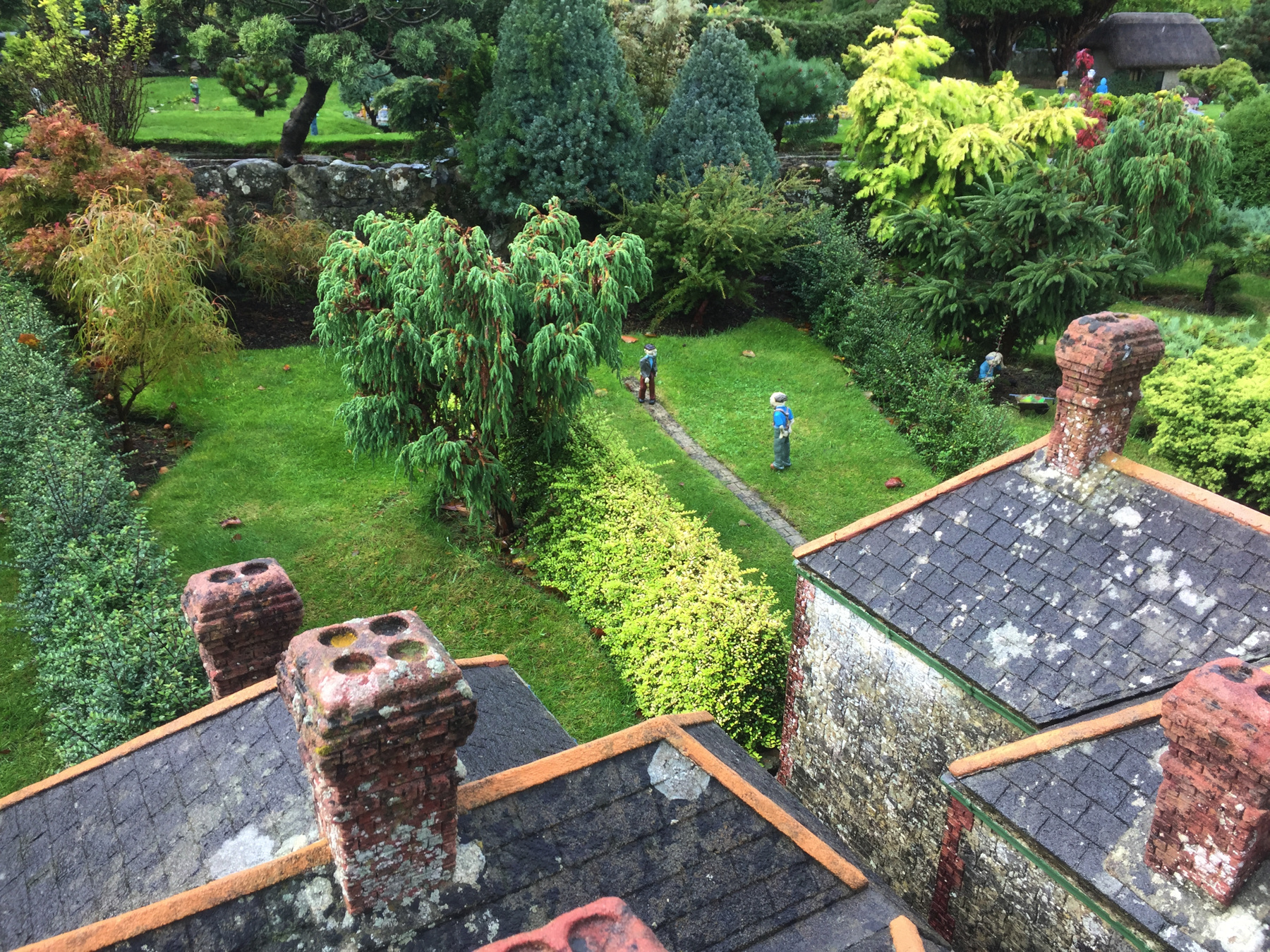
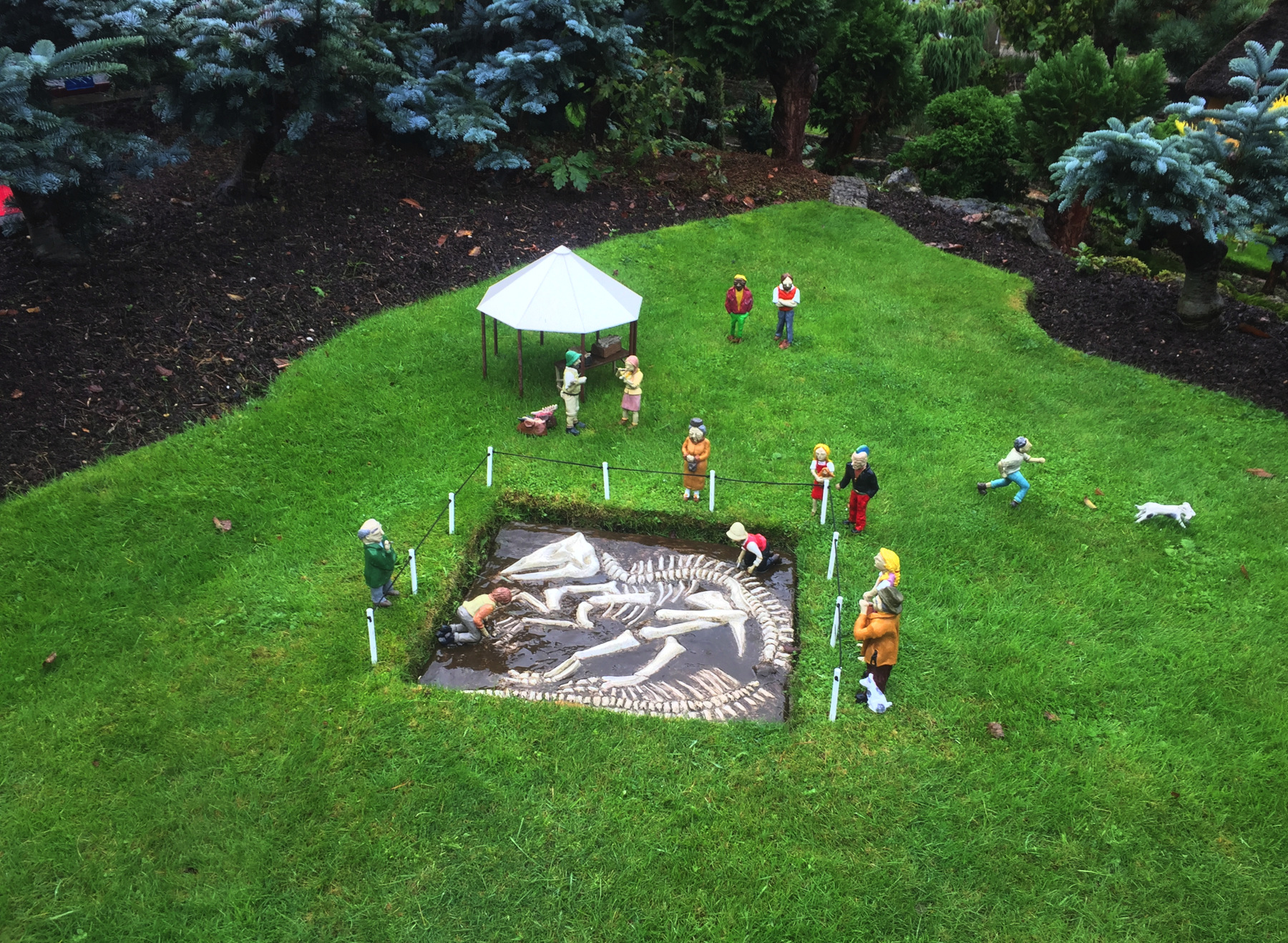
The model village includes scenes of other places on the island. The dig reminds us that the Isle of Wight is a rich source of fossils of dinosaurs and early mammals. There is a museum of local finds at Sandown.
The models are all 1:10 scale, and so the models of the models are 1:100 scale. But there is one object present only at the smaller scale, since otherwise it would dwarf the village itself.

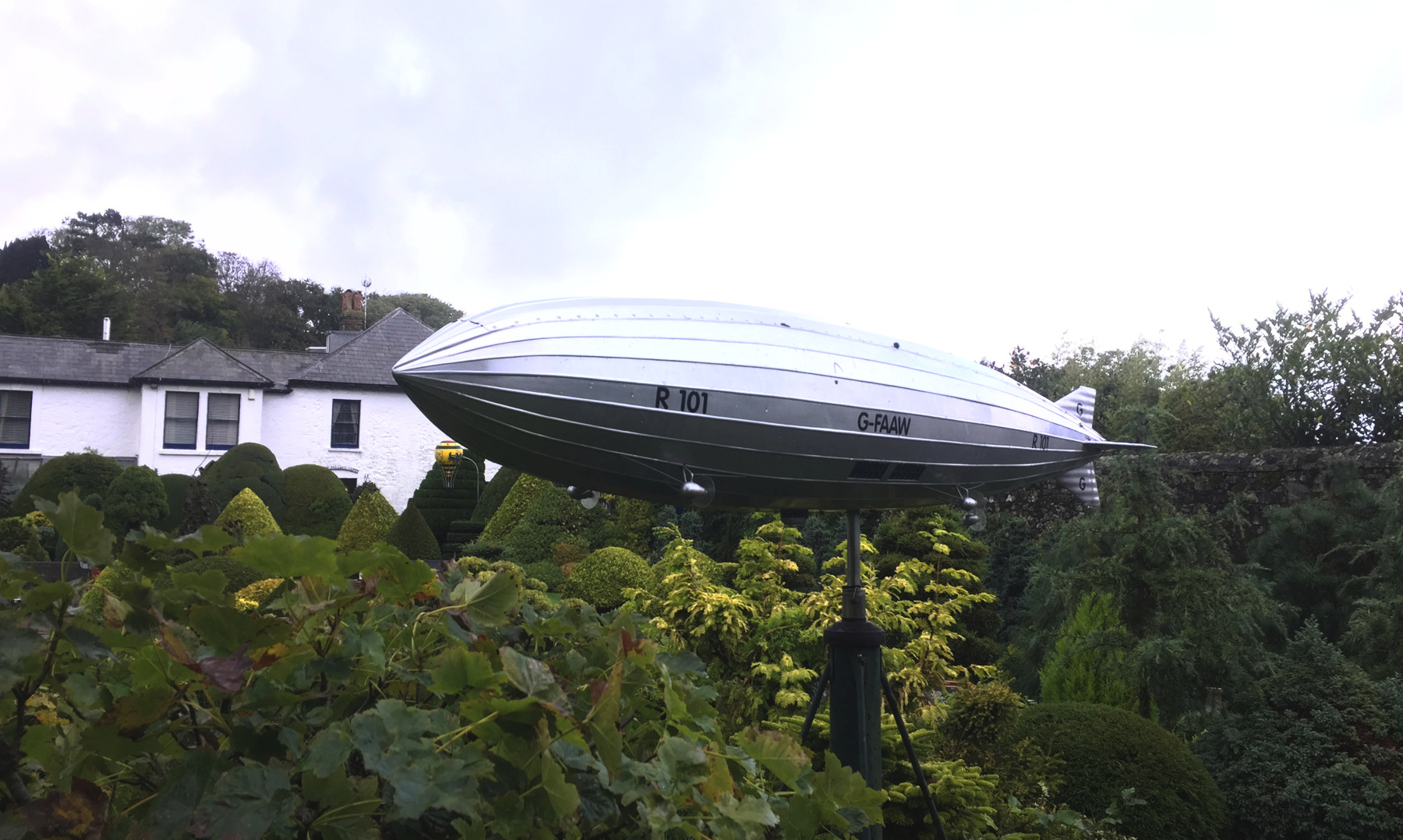
What a way to travel? R101 crashed and burned in France on its maiden voyage to India, killing almost everyone on board. It was a tragic story of great dreams and hard work, dashed in an instant. The struggle toward progress goes down many false roads. But it is the Gift of Men, as J.R.R. Tolkien called it (the Gift of Humanity I would say), to be dissatisfied with the world's limitations and seek that "everything should be, in form and deed, completed, and the world fulfilled" (The Silmarillion).
Time to head back to Shanklin.
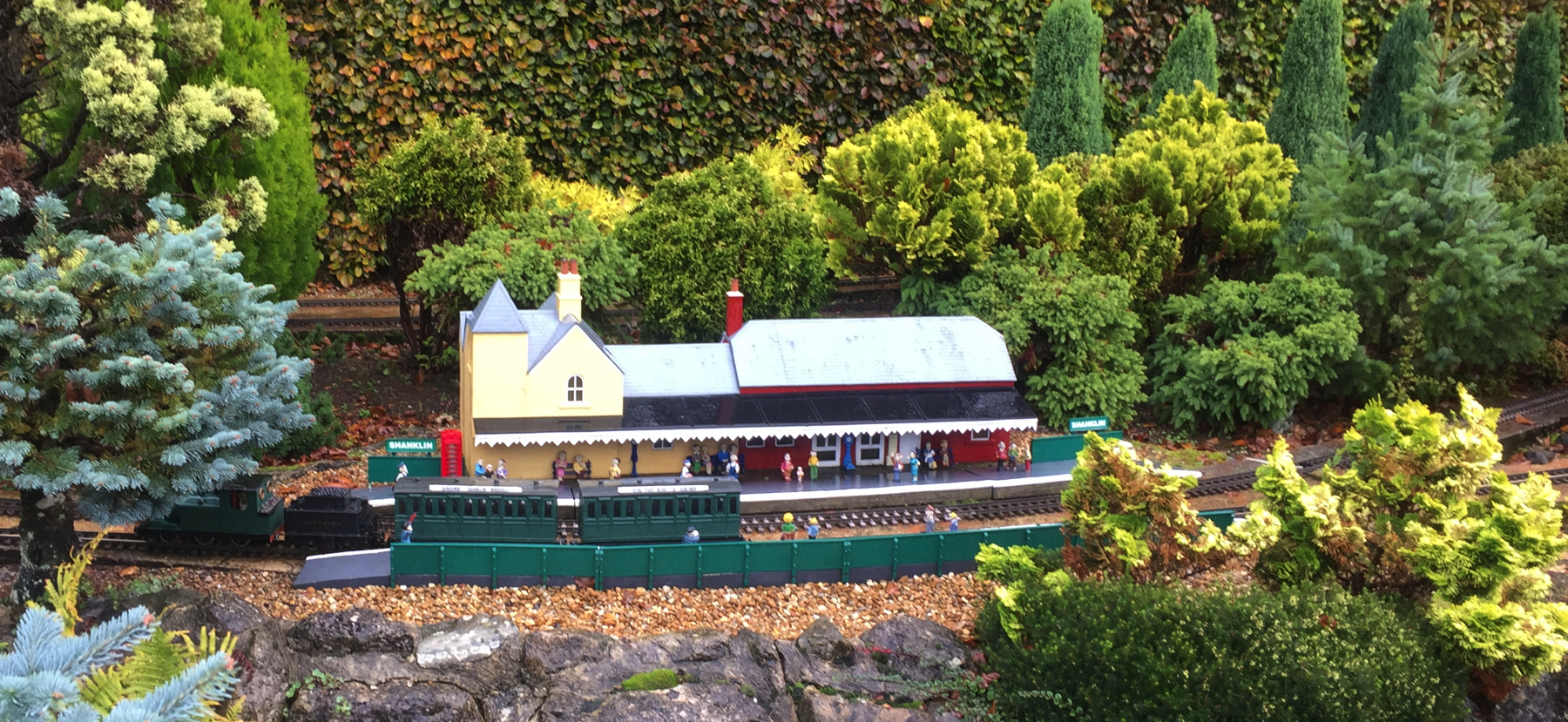

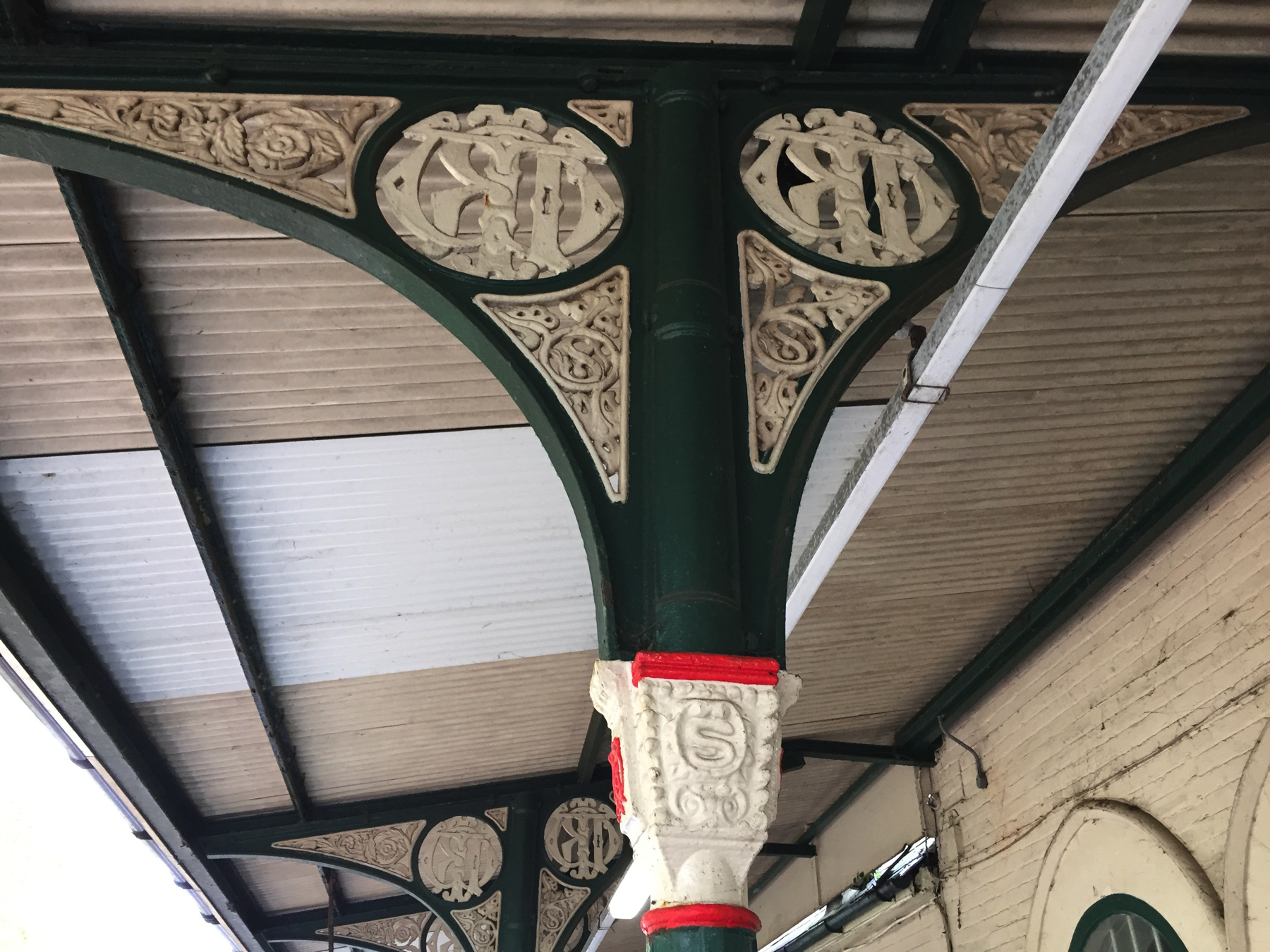
A detail of the ironwork shows an S for Shanklin. This was the the terminal in 1864, but a few years later the railway was completed to Ventnor on the south coast. Reopening the southern section is proposed from time to time.
On this occasion my strategy of starting the day early was the wrong one. The weather finally cleared for good when I was on my way back.
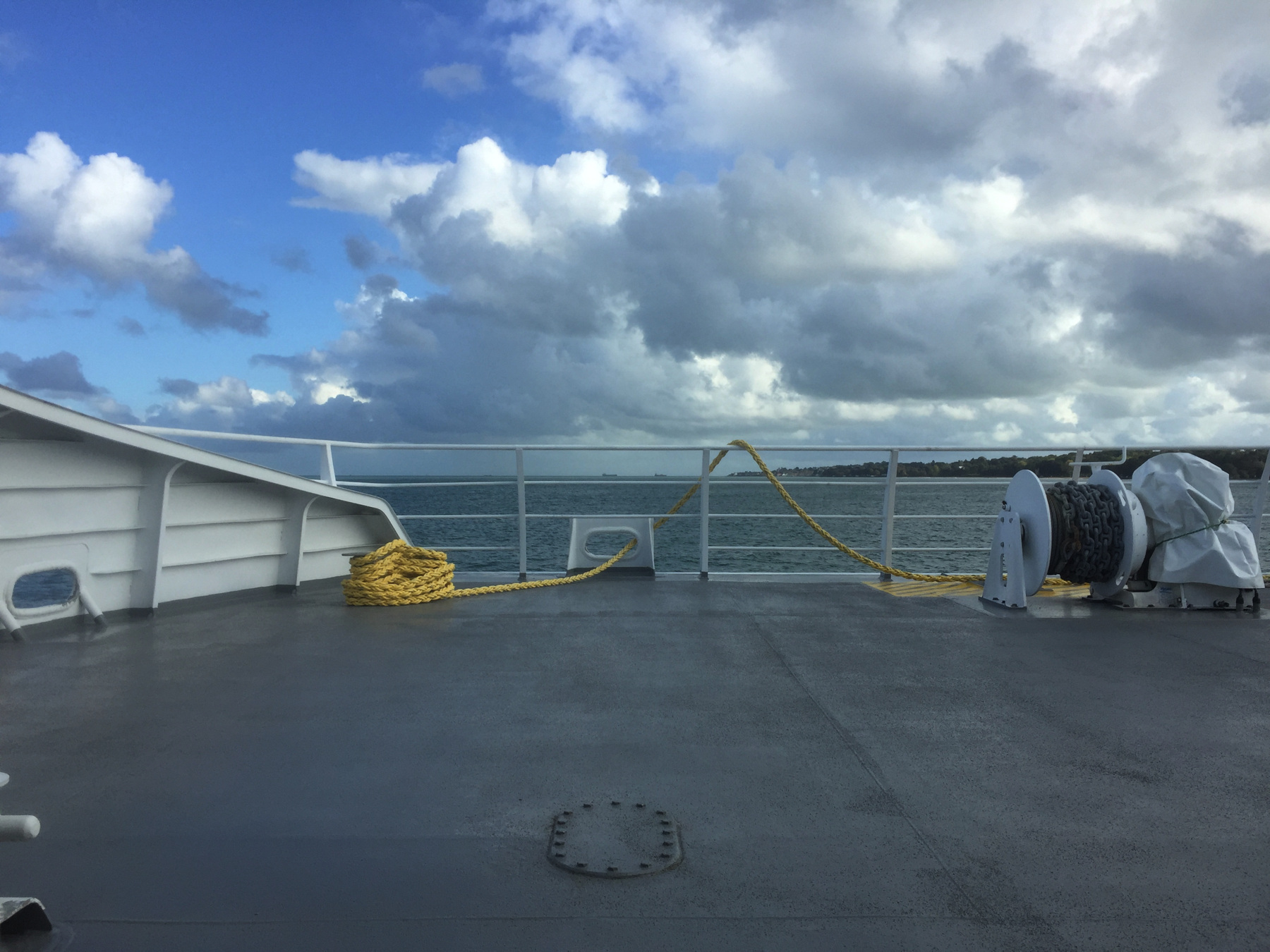
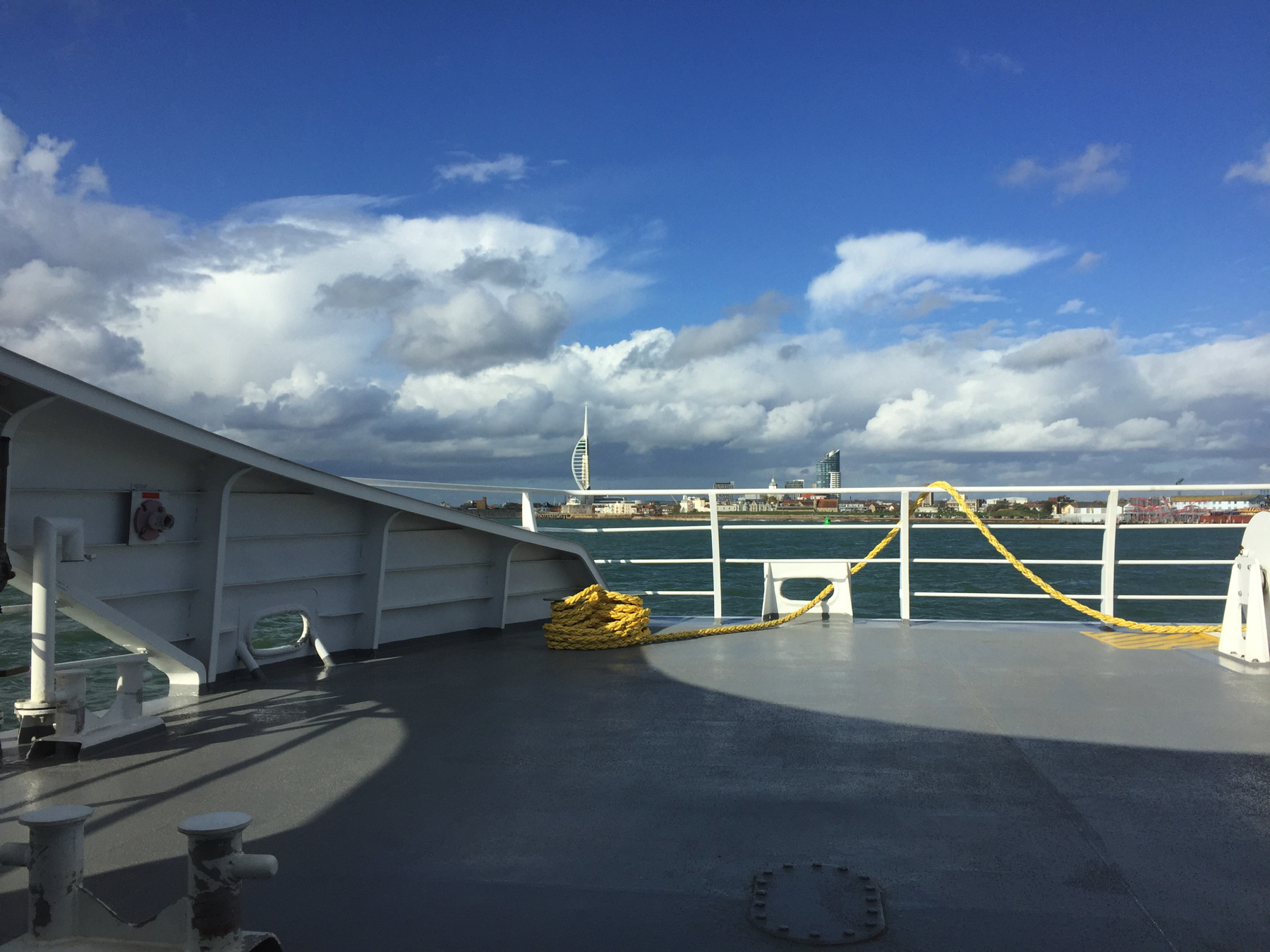
I wondered going and coming about that needle of a tower at Portsmouth, located close to the Harbour station. It was to be called the Portsmouth Millennial Tower, but since it missed its 1999 opening date, when it was finally complete in 2005 it was called the Spinnaker Tower. The design was meant from the start to represent a spinnaker, a type of sail that billows out in the wind. It was renamed in 2015 the Emirates Spinnaker Tower in honor of a repressive nation in the Middle East that has cash to spare for naming rights. You can go up to the top for not too much more than £10. I learned all of this later.
Martin Easdown's well-titled book Cliff Railways, Lifts, and Funiculars includes the rest of the vertical elevator "cliff lifts." I will not include the others on these pages but here is the complete list:
Madeira Drive Lift, Brighton. 1890-.
Lift, Shanklin. 1893-1940, 1957-.
Marina Lift, Ramsgate. 1907-1970.
Harbour Lift, Ramsgate. 1910-.
West Cliff Lift, Ramsgate. 1929-1993.
Cabin Lift, Blackpool. 1930-1979, 1991-1992.
West Cliff Lift, Whitby. 1931-.
Walpole Bay Lift, Margate. 1934-2009.
Viking Bay Lift, Broadstairs. 2000-.
Hill Lift, Southend-on-Sea, 2004-.
I feel foolish not to have noticed those in Brighton, Broadstairs, Margate, and Whitby, where I have been, and I could have seen the three at Ramsgate on the day I went to Broadstairs, leaving only Blackpool outside the scope of my visits. But I will lose no sleep over it. One has to draw the line.
[note 1] Wight and Thanet share a history that their first Germanic landings after the Romans left were by Jutes, not the better known Angles and Saxons. A Jutish kingdom was founded some time in the sixth century, but its name Wihtwara means simply "Wiht men" ("wara" as in werewolf) and so it does not explain the name Wiht.
The earliest document we have that seems to mention Wight is the Ιστορικη Βιβλιθηκη, Historical Library, by Diodorus of Sicily. His life's work, he spent decades compiling it from every source available to him, in the middle of the first century BCE. He mentions an island called Ικτις in his Book 5, Chapter 22, of which the following is a Loeb Classical Library translation:
[From tin mines in Cornwall] the workers quarry the ore, which they then melt down and cleanse of its impurities. Then they work the tin into pieces the size of knuckle-bones and convey it to an island which lies off Britain and is called Ictis; for at the time of ebb-tide the space between this island and the mainland becomes dry and they can take the tin in large quantities over to the island on their wagons. ... On the island of Ictis the merchants purchase the tin of the natives and carry it from there across the Strait to Galatia or Gaul; and finally, making their way on foot through Gaul for some thirty days, they bring their wares on horseback to the mouth of the river Rhone.The identification of this Iktis with Wight is not at all agreed. The other site suggested is St Michael's Mount in Cornwall. Which is more likely? For St Michael's Mount I have to believe that merchants in a trans-channel shipping enterprise chose to establish their trading post on a small rock of an island that offers no shelter for boats and maybe not even fresh water. For Wight I have to believe that the Cornish miners brought their nuggets of tin to a market two hundred miles up the coast. And yet my feeling is that Wight is correct.
The passage by cart only at low tide is probably the main reason for identifying Iktis with St Michael's Mount, which is accessible only in that manner at the present day. In 1907 an historian called Clement Reid proposed that two thousand years ago there might have been a passage across the Solent at low water near modern Yarmouth. But I don't think we need to prove that. Long distance travel by land is difficult in southwest England: there are so many rivers and so many deep valleys. More likely the miners took the metal down to the sea by the shortest route and then transported it by boat along the coast. Lack of a safe harbor at St Michael's Mount does not rule out using small boats that could be pulled ashore (like those at The Stade in Hastings).
Why was tin so valuable? Mixed with copper, it forms bronze, and that is the key here. The Romans had good sources of copper in Cyprus and Spain, but tin was less abundant. Diodorus's distinction between the merchants and the "natives" suggests that the merchants on Iktis were Roman and the miners were not. The reason to bring tin so far from the mines was to get the best exchange of goods.
The next accounts we have are from the second century CE. Suetonius completed his work De Vita Caesarum, the Lives of the Caesars, in about 120 CE. He mentions that the emperor Vespasian, while serving in the army under the emperor Claudius in about 43 CE, conquered duas validissimas gentes superque viginti oppida et insulam Vectem Britanniae proximam, that is, "two powerful nations, more than twenty towns, on the island vectem near Britain." The word vectem looks like the accusative singular of the common noun vectis, which has meanings like "bar", "plow", "lever". Modern translations of Suetonius treat vectis as the name of the island. It is sometimes said to be the feminine Vecta but then the form vectem would not be correct.
However not long after Diodorus we have from about 150 CE the Γεωγραφικη Υφηγησις, Geographical Guidance of Ptolemy. Most of his text describes how to draw maps of the known world. In Book 2, Chapter 3, he describes an island as: υποδε Μεγαν λιμενα νησος Ουικτις, that is, "below the Great Gate [presumably the Solent], the island Wiktis" (spelled as the French would, Ouiktis). Ptolemy's coordinates locate Wiktis as the Isle of Wight, and confirms that it or "Vectis" is a proper name that may well go back to the Iktis of Diodorus's history two hundred years earlier.
But we want to get the origin of the name. There are proponents of a Celtic origin although the derivation is not obvious. Since Diodorus puts merchants who were not "natives" on the island a century before the Roman conquest of Britain, it could be that their Latin name for the place is the name that stuck. The position of the Isle of Wight blocks a direct path to Southampton, and its diamond shape bends the Solent. We have only to believe that the short vowel wandered between e and i and that the c softened to something like a Scottish or German ch to get to wiht.
I could not find anything about a Carthaginian goddess with a name like WKT.
The word "wight" as a term for an unfortunate human being or even an "undead" human (as Tolkien uses it) is a separate development.
The bus company on the island is called Southern Vectis. It was called Vectis until it was acquired by the Southern Railway in 1929, and since then it has retained the name Southern Vectis.
TODAY'S FUNICULAR CLIFF LIFT
Lift, Shanklin
Date: since 1957
Power: Electric motor
Rise: 150 feet
Run: zero
Length: 150 feet
Slope: vertical
Gauge: none
Track: none
Car: level floor, doors at ends
The present lift replaced a hydraulic elevator opened in 1891 that was housed in a completely different structure. The old lift was destroyed during the war in 1940. A new lift was opened in 1957 with the tower building that is now in use, but in 2016 the footbridge, motors, and cars were replaced.
CLAIMS: Nothing in particular.
HEIGHT: 150 feet.
TODAY'S ALE
The Taverners, Godshill: Brains Brewery, Reverend James (cask ale)